Financing Global Health 2023
The Future of Health Financing in the Post-Pandemic Era

The Future of Health Financing in the Post-Pandemic Era
The Future of Health Financing in the Post-Pandemic Era
INSTITUTE FOR HEALTH METRICS AND EVALUATION
UNIVERSITY OF WASHINGTON
This report was prepared by the Institute for Health Metrics and Evaluation (IHME) through core funding from the Bill & Melinda Gates Foundation. The views expressed are those of the authors.
The contents of this publication may be reproduced and redistributed in whole or in part, provided the intended use is for noncommercial purposes, the contents are not altered, and full acknowledgment is given to IHME.
This work is licensed under the Creative Commons Attribution-NonCommercial-NoDerivs 4.0 Unported License. To view a copy of this license, please visit https://creativecommons.org/licenses/by-nc-nd/4.0/. For any usage that falls outside of these license restrictions, please contact IHME Global Engagement at engage@healthdata.org.
Citation: Institute for Health Metrics and Evaluation (IHME). Financing Global Health 2023: The Future of Health Financing in the Post-Pandemic Era. Seattle, WA: IHME, 2024.
Institute for Health Metrics and Evaluation 3980 15th Ave NE
Seattle WA 98195
USA www.healthdata.org
Printed in the United States of America
ISBN 978-1-7341306-1-4
To request copies of this report, please contact IHME:
Telephone: +1-206-897-2800
Fax: +1-206-897-2899
Email: engage@healthdata.org
© 2024 Institute for Health Metrics and Evaluation
DAH Development assistance for health
GDP Gross domestic product
HSS Health systems strengthening
IMF International Monetary Fund
NGO Non-governmental organization
ODA Official development assistance
OECD Organisation for Economic Co-operation and Development
PEPFAR President’s Emergency Plan for AIDS Relief
SWAPS Sector-wide approaches
UNICEF United Nations Children’s Fund
UNOCHA United Nations Office for the Coordination of Humanitarian Affairs
Angela E. Apeagyei, PhD
Joseph L. Dieleman, PhD
Katherine Leach-Kemon, MPH
Enis Barış, MD, PhD
Ian E. Cogswell, BS
Hans Elliott, MS
Brendan Lidral-Porter, MA
Christopher J.L. Murray, MD, DPhil
Seong Nam, BS
Shuhei Nomura, PhD
Nishali K. Patel, MSc
Carolyn Shyong, MPS
Juan Solorio, MS
Golsum Tsakalos, MS
Wesley Warriner, BA
Asrat A. Wolde, MPH
Dereje Y. Yada, MS
Yingxi Zhao, DPhil
Bianca Zlavog, MS
First, we would like to thank past contributors to the Financing Global Health series of reports for developing and refining the analytical foundation upon which this work is based. We would also like to acknowledge the staff members of the numerous development agencies, public-private partnerships, international organizations, non-governmental organizations, and foundations who responded to our data requests and questions. We appreciate their time and assistance. We would also like to acknowledge the broader efforts of the IHME community, which contributed greatly to the production of this year’s report. In particular, we thank IHME’s Board for their continued leadership, Adrienne Chew and Rebecca Sirull for editing, Joan Williams for her steadfast production oversight and publication management, and Michaela Loeffler for design. Finally, we would like to extend our gratitude to the Bill & Melinda Gates Foundation for generously funding IHME and for its consistent support of this research and report.
An independent population health research organization based at the University of Washington School of Medicine, the Institute for Health Metrics and Evaluation (IHME) works with collaborators around the world to develop timely, relevant, and scientifically valid evidence that illuminates the state of health everywhere. In making our research available and approachable, we aim to inform health policy and practice in pursuit of our vision: all people living long lives in full health. For more information about IHME and its work, please visit www.healthdata.org.
In addition to conducting the Financing Global Health study, IHME coordinates the Global Burden of Diseases, Injuries, and Risk Factors (GBD) Study, a comprehensive effort to measure epidemiological levels and trends worldwide. (More information on GBD is available at https://www.healthdata.org/researchanalysis/gbd.) The GBD study relies on a worldwide network of more than 10,000 collaborators in over 160 countries and territories. Current collaborator areas of expertise include epidemiology, public health, demography, statistics, and other related fields. IHME has expanded the scope of GBD to encompass quantification of health resource flows, health system attributes, and the performance of health systems. To that end, IHME is seeking GBD collaborators who are experts in health financing and health systems. GBD collaborators –many of whom have co-authored GBD or Financing Global Health publications – provide timely feedback related to the interpretation of GBD and Financing Global Health results, data sources, and methodological approaches pertaining to their areas of expertise. We invite researchers and analysts with expertise in health financing to join the GBD Collaborator Network. Potential collaborators may apply at https://www.healthdata.org/researchanalysis/gbd/collaborator-network
IHME’s Financing Global Health report provides an overview of health spending around the world, with a special focus on investments in health in low- and middle-income countries. The report examines how this funding for health is changing each year and forecasts how it may change in the future. Financing Global Health examines where money for health originates and what health issues it funds.
This year, Financing Global Health 2023 looks at how interest payments on loans that many countries took out during the COVID-19 pandemic to keep their economies afloat and their people protected are now straining health budgets. It also details how development partners’ investments in health in low- and middleincome countries – development assistance for health – have changed since reaching historic levels during the COVID-19 pandemic, dropping by $19.4 billion between 2021 and 2023, from $84.0 billion to $64.6 billion.
When the COVID-19 pandemic hit, loans were a lifeline for countries of all income levels, allowing governments to provide food, housing, and medical care. These loans also helped countries roll out lifesaving COVID-19 vaccines once they became available. Now, countries are paying back the loans, and their interest payments have increased sharply as interest rates have spiked. Low-income countries’ interest payments more than doubled between 2019 and 2023.
Low-income countries are particularly vulnerable to these economic stressors, and their health budgets are suffering, decreasing by 8.6% on average between 2020 and 2023. Compounding low-income countries’ challenges, some development partners are cutting development assistance for health as they pay back the debt that they accrued during the pandemic. IHME estimates that in 2023, 18 of 31 major sources of development assistance provided less assistance for health than they did in 2020.
Beyond economic pressure, donor countries are increasingly faced with competing priorities of what to fund, such as mitigating the effects of climate change. IHME estimates two potential future scenarios for development assistance for health. If development partners keep prioritizing health, IHME forecasts that development assistance for health will be $50.6 billion in 2030. However, if development partners prioritize other sectors, IHME forecasts that development assistance for health could drop to $36.7 billion in 2030.
Development assistance for health peaked in 2021 at an all-time high of $84.0 billion. However, as the COVID-19 emergency receded between 2021 and 2023, IHME estimates that development assistance for health dropped by 23.1%. Yet, IHME’s research indicates that development assistance for health remained 33.9% larger in 2023 than it was before the pandemic in 2019.
IHME《全球卫生筹资》报告概述了世界各地的卫生支出,特别关注低收入和中 等收入国家的卫生投资。该报告研究了卫生筹资的年度变化情况,并预测了未来 的可能变化。《全球卫生筹资》研究了卫生资金的来源以及资助的卫生问题。
今年,《2023年全球卫生筹资》研究了许多国家在新冠肺炎(COVID-19)疫情 期间为维持经济发展和保护人民而获取的贷款产生的利息支出如今如何导致卫生 预算紧张。该报告还详细介绍了发展合作伙伴对低收入和中等收入国家的卫生投 资(卫生发展援助)自新冠肺炎(COVID-19)疫情期间达到历史最高水平以来 发生的变化,投资金额从2021年的840亿美元下降到2023年的646亿美元,减少 了194亿美元。
偿还债务可导致卫生资源减少
新冠肺炎(COVID-19)疫情期间,贷款是众多国家(无论收入水平)的生命线, 让政府能够提供食品、住房和医疗服务。这些贷款还帮助各国在救生的新冠肺炎 (COVID-19)疫苗上市后推出这些疫苗。现在,各国正在偿还贷款,但随着利 率飙升,支付的利息也急剧增加。2019年至2023年,低收入国家的利息支出增 加了一倍多。
低收入国家特别容易受到这些经济压力的影响,其卫生预算受到影响,2020年至 2023年间平均减少了8.6%。一些发展合作伙伴正在削减卫生发展援助,以帮助 偿还其自身在疫情期间累积的债务,这使低收入国家面临的挑战更加复杂。IHME 估计,31个主要发展援助来源中有18个在2023年提供的卫生援助少于2020年。
发展合作伙伴在转变优先事项,这对卫生发展援助的持续增 长造成威胁
除了经济压力之外,捐助国还面临着越来越多的相互竞争的优先资助事项,例 如减轻气候变化的影响。IHME估计了未来卫生发展援助的两种潜在情景。如果 发展合作伙伴继续优先考虑卫生问题,IHME预计到2030年,卫生发展援助将达 到506亿美元。但是,如果发展合作伙伴优先考虑其他事项,IHME预计到2030 年,卫生发展援助可能会下降至367亿美元。
2021年后卫生发展援助下降
卫生发展援助于2021年达到历史最高水平,为840亿美元。但是,随着2021年至 2023年新冠肺炎(COVID-19)突发事件的缓解,IHME估计卫生发展援助下降 了23.1%。但是,IHME的研究表明,2023年卫生发展援助仍比2019年疫情之前 增加了33.9%。
сферы всемирного здравоохранения исследуются источники финансирования сферы здравоохранения, а также медицинские проблемы, для решения которых выделяются средства.
В этом году в отчете Финансирование сферы всемирного здравоохранения в 2023 году рассмотрено, как выплата процентов по кредитам, которые многие страны взяли во время пандемии COVID-19, чтобы удержать свою экономику на плаву и защитить население, теперь создает нагрузку на бюджеты сферы здравоохранения. В нем также подробно описано, как изменились инвестиции партнеров в развитие здравоохранения (содействие развитию здравоохранения) стран с низким и средним уровнем дохода по достижении ретроспективных показателей во время пандемии
COVID-19, снизившись на 19,4 млрд долл. США за период с 2021 по 2023 год (с 84,0 млрд долл. США до 64,6 млрд долл. США).
Погашение долга может привести
на здравоохранение
Когда началась пандемия COVID-19, кредиты стали спасением для стран с любым уровнем дохода, позволив правительствам обеспечить население продовольствием, жильем и медицинским обслуживанием. Эти
также помогли странам обеспечить
долл. США. В то же время, если партнеры по развитию отдадут приоритет другим секторам, IHME прогнозирует снижение помощи на цели развития
здравоохранения до 36,7 млрд долл. США в 2030 году.
Помощь на цели развития здравоохранения сократилась
Le rapport Financing Global Health de l’IHME offre une vue d’ensemble des dépenses de santé à travers le monde, en mettant l’accent sur les investissements dans la santé dans les pays à revenus faible et intermédiaire. Le rapport se penche sur l’évolution du financement de la santé chaque année et prévoit comment il pourrait évoluer à l’avenir. Le rapport Financing Global Health examine d’où provient l'argent destiné à la santé et quels problèmes il permet de financer.
Cette année, le rapport Financing Global Health 2023 analyse le poids qui pèse aujourd'hui sur les budgets de santé en raison des paiements d’intérêts sur les prêts contractés par de nombreux pays durant la pandémie de COVID-19 pour maintenir leur économie à flot et protéger leur population. De même, il explique comment les investissements des partenaires de développement dans les pays à revenus faible et intermédiaire - l’aide au développement pour la santé - ont évolué après avoir atteint des niveaux historiques pendant la pandémie de COVID-19, accusant une baisse de 19,4 milliards de dollars entre 2021 et 2023, et passant de 84 à 64,6 milliards de dollars.
Le remboursement de la dette peut se traduire par une baisse des ressources pour la santé
Lorsque la pandémie de COVID-19 a frappé, les prêts constituaient une bouée de sauvetage pour les pays, quel que soit leur niveau de revenu. Ils ont permis aux gouvernements de fournir de la nourriture, des logements et des soins de santé. Ils ont également permis aux pays de déployer des vaccins permettant de sauver des vies une fois ceux-ci disponibles. À présent, les pays doivent rembourser ces prêts et les paiements d'intérêts ont fortement augmenté avec l’envolée des taux d'intérêt. Les paiements d'intérêts pour les pays à faible revenu ont plus que doublé entre 2019 et 2023.
Ces pays sont particulièrement vulnérables à ces facteurs économiques et leurs budgets de santé en font les frais, accusant une baisse de 8,6 % en moyenne entre 2020 et 2023. À ces difficultés vient s'ajouter le fait que certains partenaires de développement réduisent l’aide au développement pour la santé car ils doivent rembourser la dette accumulée durant la pandémie. L’IHME estime qu’en 2023, 18 des 31 principales sources d'aide au développement ont fourni une aide pour la santé inférieure à celle de 2020.
Les changements de priorités des partenaires de développement menacent la croissance continue de l’aide au développement pour la santé
Au-delà des pressions économiques, les pays donateurs font de plus en plus face à des priorités de financement concurrentes, l’atténuation des effets du changement climatique étant un exemple. L’IHME envisage deux scénarios futurs potentiels pour l'aide au développement pour la santé. Si les partenaires de développement continuent d'accorder la priorité à la santé, l’IHME prévoit que l’aide au développement pour la santé s’élèvera à 50,6 milliards de dollars en 2030. Toutefois, s’ils donnent la priorité à d'autres secteurs, l’aide au développement pourrait descendre à 36,7 milliards de dollars en 2030, selon l’IHME.
L’aide au développement pour la santé a chuté après 2021
L’aide au développement pour la santé a atteint un niveau record de 84 milliards de dollars en 2021. Cependant, alors que la situation d’urgence liée à la COVID-19 s’est résorbée entre 2021 et 2023, l’IHME estime que l’aide au développement pour la santé a chuté de 23,1 %. Pourtant, les recherches de l’IHME indiquent qu’en 2023 l’aide au développement pour la santé demeurait 33,9 % supérieure par rapport au niveau pré-pandémique de 2019.
El informe Financiación de la salud en el mundo (Financing Global Health) del IHME ofrece un resumen del gasto en salud en todo el mundo, con especial enfoque sobre las inversiones en salud en los países de rentas bajas y medias. Este informe examina el modo en que la financiación para la salud varía cada año y predice cómo podría cambiar en el futuro. Financiación de la salud en el mundo examina de dónde procede el dinero para la salud y qué asuntos relacionados con la salud financia. Este año, Financiación de la salud en el mundo 2023 analiza el modo en que los pagos de intereses por los préstamos que muchos países tomaron durante la pandemia de COVID-19 para mantener su economía a flote y proteger a la población están ahora asfixiando los presupuestos para salud. También detalla cómo las inversiones de los socios de desarrollo en salud en países de rentas bajas y medias (asistencia al desarrollo para la salud) han cambiado desde que alcanzaron niveles históricos durante la pandemia de COVID-19, con una caída de 19 400 millones de dólares entre 2021 y 2023: de 84 000 millones a 64 600 millones de dólares.
El pago de la deuda puede traducirse en menos recursos para la salud
Cuando se desencadenó la pandemia de COVID-19, los préstamos supusieron un salvavidas para países de todos los niveles de renta y permitieron a los gobiernos proporcionar comida, alojamiento y atención médica. Estos préstamos también ayudaron a los países a distribuir las vacunas contra la COVID-19, que salvaron vidas una vez que estuvieron disponibles. Actualmente, los países están devolviendo esos préstamos, y los pagos de intereses han escalado drásticamente al producirse un repunte en los tipos de interés. Los pagos de intereses de los países de rentas bajas han aumentado a más del doble entre 2019 y 2023.
Los países de rentas bajas son especialmente vulnerables a estos factores de estrés económico y sus presupuestos para la salud están padeciéndolo, con bajadas de un 8,6 % de media entre 2020 y 2023. Para agravar más los desafíos de los países de rentas bajas, muchos socios de desarrollo están recortando la asistencia al desarrollo para la salud en lo que pagan la deuda que contrajeron durante la pandemia. El IHME estima que, en 2023, 18 de las 31 fuentes principales de asistencia al desarrollo ofrecieron menos asistencia para la salud que en 2020.
Los cambios en las prioridades de los socios de desarrollo amenazan el curso del crecimiento en asistencia al desarrollo para la salud
Más allá de las presiones económicas, los países donantes se enfrentan cada vez más a prioridades en competencia sobre qué subvencionar, por ejemplo, la mitigación de los efectos del cambio climático. El IHME anticipa dos posibles escenarios futuros en la asistencia al desarrollo para la salud. Si los socios de desarrollo siguen priorizando la salud, el IHME predice que la asistencia al desarrollo para la salud será de 50 600 millones de dólares en 2030. Sin embargo, si los socios de desarrollo dan prioridad a otros sectores, el IHME predice que la asistencia al desarrollo para la salud podría bajar a 36 700 millones de dólares en 2030.
La asistencia al desarrollo para la salud disminuyó después de 2021
La asistencia al desarrollo para la salud tocó techo en 2021, con un máximo histórico de 84 000 millones de dólares. Sin embargo, con el retroceso de la emergencia por COVID-19 entre 2021 y 2023, el IHME estima que la asistencia al desarrollo para la salud disminuyó un 23,1 %. A pesar de ello, las investigaciones del IHME indican que la asistencia al desarrollo para la salud se mantuvo un 33,9 % más alta en 2023 de lo que era antes de la pandemia en 2019.
O relatório de Financiamento da Saúde Global do IHME oferece uma visão geral das despesas de saúde ao redor do mundo, com um foco especial nos investimentos em saúde em países de baixa e média renda. O relatório examina como este financiamento da saúde está variando a cada ano e prevê como ele pode mudar no futuro. O Financiamento da Saúde Global examina de onde se origina o dinheiro destinado à saúde e quais problemas de saúde ele custeia. Este ano, o Financiamento da Saúde Global de 2023 avalia como os pagamentos dos juros sobre empréstimos que muitos países fizeram durante a pandemia de COVID-19 para manter as suas economias em funcionamento e as suas populações protegidas estão agora sobrecarregando os orçamentos para saúde. Ele também detalha como os investimentos na saúde em países de baixa e média renda feitos por parceiros de desenvolvimento — assistência ao desenvolvimento da saúde — mudaram desde que atingiram níveis históricos durante a pandemia de COVID-19, apresentando queda de US$19,4 bilhões entre 2021 e 2023, de US$84,0 bilhões para US$64,6 bilhões.
O pagamento de dívidas pode ser traduzido como uma diminuição dos recursos para a saúde
Quando a pandemia de COVID-19 surgiu, os empréstimos representaram uma salvação para os países com todos os níveis de renda, permitindo que os governos fornecessem comida, alojamento e assistência médica. Esses empréstimos também ajudaram os países a lançar as vacinas para COVID-19 que salvaram vidas após elas ficarem disponíveis. Agora, os países estão pagando os empréstimos e seus pagamentos de juros aumentaram acentuadamente à medida que as taxas de juros dispararam. Os pagamentos de juros de países de baixa renda mais do que duplicaram entre 2019 e 2023. Os países de baixa renda são especialmente vulneráveis a esses fatores de estresse econômico e seus orçamentos para saúde estão sofrendo, tendo diminuído em 8,6%, em média, entre 2020 e 2023. Agravando os desafios dos países de baixa renda, alguns parceiros de desenvolvimento estão cortando a assistência ao desenvolvimento da saúde conforme pagam a dívida que acumularam durante a pandemia. O IHME estima que, em 2023, 18 das 31 principais fontes de assistência ao desenvolvimento forneceram menos assistência para a saúde do que forneceram em 2020.
As mudanças das prioridades dos parceiros de desenvolvimento ameaçam o crescimento contínuo na assistência ao desenvolvimento da saúde
Além da pressão econômica, os países doadores enfrentam cada vez mais prioridades concorrentes com relação ao que financiar, como a mitigação dos efeitos das alterações climáticas. O IHME prevê dois possíveis cenários futuros para a assistência ao desenvolvimento da saúde. Se os parceiros de desenvolvimento continuarem a priorizar a saúde, o IHME prevê que a assistência ao desenvolvimento da saúde será de US$50,6 bilhões em 2030. No entanto, se os parceiros de desenvolvimento priorizarem outros setores, o IHME prevê que a assistência ao desenvolvimento da saúde poderia cair para US$36,7 bilhões em 2030.
A assistência ao desenvolvimento da saúde diminuiu após 2021
A assistência ao desenvolvimento da saúde culminou em 2021, com um máximo histórico de US$84,0 bilhões. No entanto, conforme a emergência da COVID-19 retrocedeu entre 2021 e 2023, o IHME estima que a assistência ao desenvolvimento da saúde tenha diminuído em 23,1%. Ainda assim, a pesquisa do IHME indica que a assistência ao desenvolvimento da saúde permaneceu 33,9% maior em 2023 do que era antes da pandemia em 2019.
The world is still recovering from the lingering impact of the COVID-19 pandemic. Financing Global Health 2023 examines how countries continue to grapple with the economic damage that it caused. Many countries borrowed money from creditors during the crisis to build systems to respond to the virus and to provide those in need with food and health care, and eventually to procure and deliver vaccines. Repaying those loans has come at a large cost as interest rates have climbed, especially for countries with the lowest incomes. Making matters worse, the financial assistance that development partners provide to low-income countries for health has shrunk compared to the all-time high of $84.0 billion in 2021.
Global health funding has contributed to historic progress in saving lives around the world. Despite the nearly 16 million deaths caused by COVID-19 in 2020 and 2021 combined, recent studies by IHME and its collaborators indicate that the world has made incredible strides in improving health since 1950 – life expectancy increased by nearly 23 years1 between then and 2021. Now, as governments in low-income countries face mounting loan repayments and declining development assistance for health, these historic health achievements could be at risk.
IHME has been publishing Financing Global Health since 2009. Here is what is new in this year’s report:
New estimates of development assistance for health
• IHME provides estimates of development assistance for health through 2023, showing how trends have changed since the height of the COVID-19 public health emergency in 2020 and 2021.
A look at countries’ debt following the COVID-19 pandemic
• During the pandemic, many countries’ debt increased as they borrowed money to help their people weather economic hardship and get vaccinated against COVID-19.
Improved forecasts of health spending through 2030*
• IHME has updated its forecasts of development assistance for health, government health spending, and total health spending based on factors including countries’ debt and changing priorities.
* Health financing forecasts through 2050 are available on the GHDx at https://ghdx. healthdata.org/record/ihme-data/globalexpected-health-spending-2022-2050
‡ Source: https://datahelpdesk.worldbank.org/ knowledgebase/articles/906519
Box 1 Health financing terms defined
Development assistance for health: Financial and in-kind resources that are transferred through international development agencies (such as UNICEF, the United Kingdom’s Foreign, Commonwealth & Development Office, or the Bill & Melinda Gates Foundation) to low- and middle-income countries with the primary purpose of maintaining or improving health.
Commitments: Commitments are “a firm obligation, expressed in writing and backed by the necessary funds, undertaken by an official donor to provide specified assistance to a recipient country or a multilateral organisation.”2
Government health spending: Spending for health care that is derived from domestic sources and is mutually exclusive from out-of-pocket, prepaid private, and development assistance for health spending. Government spending includes spending on public health system infrastructure and governmentprovided social health insurance.
Interest payments: How much one pays to borrow money.
Total health spending: The sum of government health spending, prepaid private health spending, out-of-pocket health spending, and DAH. Total health spending does not include indirect health spending, such as lost wages due to illness or transportation costs; informal care (spending on care provided by a family member or by traditional healers); or illegal transactions.
World Bank income group: The World Bank classifies countries using gross national income (GNI) per person. This report uses the fiscal year 2024 World Bank income groups, which are high-income (GNI per person greater than $13,846), upper-middle-income ($4,466 to $13,845), lower-middleincome ($1,136 to $4,465), and lowincome ($1,135 or less).‡
The COVID-19 pandemic thrust the world into an unprecedented crisis, costing millions their lives, livelihoods, and well-being. For many countries, wealthy and non-wealthy alike, loans were a lifeline for keeping people fed and housed as economies ground to a halt. From Ghana3 to Czechia,4 government debt rose in low-, middle-, and high-income countries, and borrowing money became more expensive after the pandemic as interest rates spiked5, 6 (Figure 1).
An economic challenge that countries face is rising interest rates, which make it more expensive to pay back loans. Rising interest rates in lenders’ countries have affected rates at which countries can borrow globally. About half of all international loans are denominated in dollars and are impacted indirectly by interest rates in the US.7 Figure 1 shows how the interest rates of loans in US dollars have increased sharply, rising from 0.4% in 2020 to 5.0% in 2023. Many countries are experiencing economic hardship in the aftermath of the COVID-19 pandemic, especially countries with fewer financial resources.
Figure 1 Average US interest rate, 2010–2023
Unless otherwise indicated, all estimates are reported in 2022 inflation-adjusted US dollars. Estimates in 2022 purchasing-power parity-adjusted dollars are available at https://ghdx.healthdata.org/record/ihme-data/ global-gdp-per-capita-1960-2050-fgh-2023
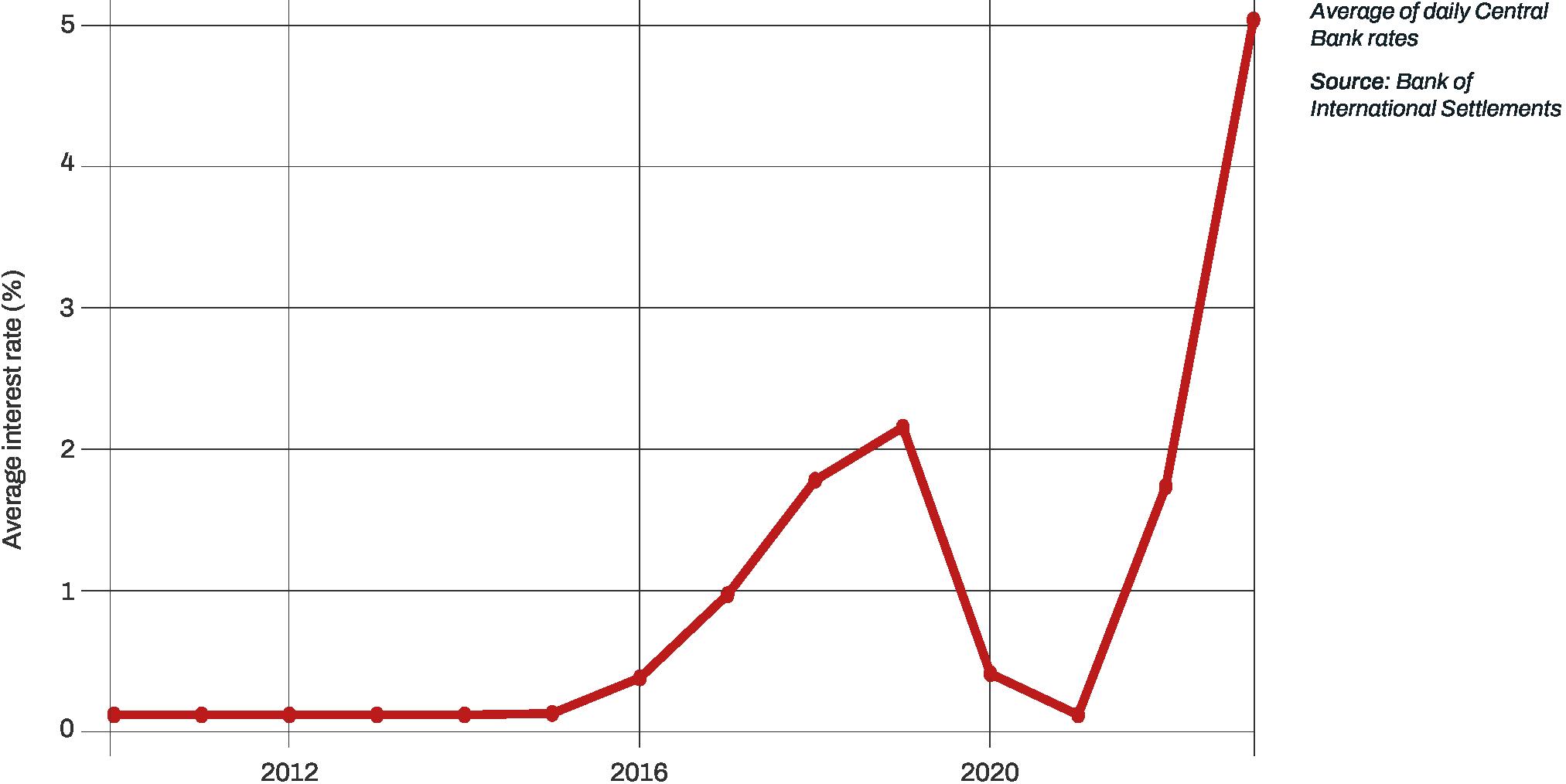
As a consequence, low-income countries face the steepest increases in interest payments relative to countries in other income groups, as shown in Figure 2.
Beyond interest payments, inflation is putting additional pressure on governments as the prices of goods and services rise.
Low-income countries are especially vulnerable to financial pressures. “When we look at low-income countries...they stepped into these shocks with very little to protect themselves, almost no buffers, and whatever they had has disappeared,” said Dr. Kristalina Georgieva, Managing Director of the International Monetary Fund, at the World Bank’s fall annual meeting in 2023.8
Figure 2 Change in interest payments relative to 2019 by World Bank income group, 2019–2028

Before dying9 at age 29 due to Hodgkin’s lymphoma, Dr. Naïmatou Moussa, a physician based in Senegal, wrote about the challenges of paying for cancer care. “I am a young doctor – I am supposed to be among the middle-income people in my country, Senegal. But I have a lot of financial difficulties in the face of this disease,” she recounted. Dr. Moussa described how the costs of treatment, paying for transportation to medical facilities, and taking medical leave from work added up. “Cancer is a disease that is very expensive,” Dr. Moussa explained. Reflecting on her experience, she wrote, “We must think about supporting more patients and think of an Africa where universal health coverage is a reality.”10
Greater debt can pressure governments in lower-income countries to reduce their health budgets or defer critical spending on health investments. Government health expenditure helps protect people from impoverishment. If governments cut health budgets, individuals are left to pay for lifesaving health care. When people must pay out of pocket for their own health care, they often must make difficult choices. Frequently, shouldering the cost of care forces families to decide between being pushed into poverty or losing their loved ones. To pay for medical care, they may have to forgo food, housing, or education. If a person doesn’t have cash on hand to pay for treatment, they may have to borrow money.
When governments pay a larger share of health spending overall, it eases the financial burden on individuals to pay for their own care. In countries where governments pay a relatively low share of health spending, it makes people more vulnerable in the face of cost-cutting measures. Government spending on health in low- and middle-income countries is far lower than what is needed to provide adequate health care. Research shows that providing basic health care costs between $60 and $86 per person,11, 12 yet the average level of government health spending in low-income countries was just $8 per person in 2023 (Figure 3).
Figure 3 Government health spending and development assistance for health by World Bank income group, 2000–2030

Given the financial strain countries are experiencing from higher debt and interest rates, IHME estimates that government spending on health in lowincome countries dropped by $1 per person between 2020 and 2023 (Figure 3). IHME anticipates that it will take an additional seven years for low-income
countries to return to the same level of government spending that they had during the pandemic, at $10 per person.
As low-income countries pay back the debt they accrued during the pandemic, they have encountered an additional challenge – development assistance for health is shrinking relative to the historic gains seen in 2020 and 2021. Between 2021 and 2023, IHME’s preliminary estimates suggest that development assistance for health dropped by 23.1%, or $19.4 billion (Figure 4).
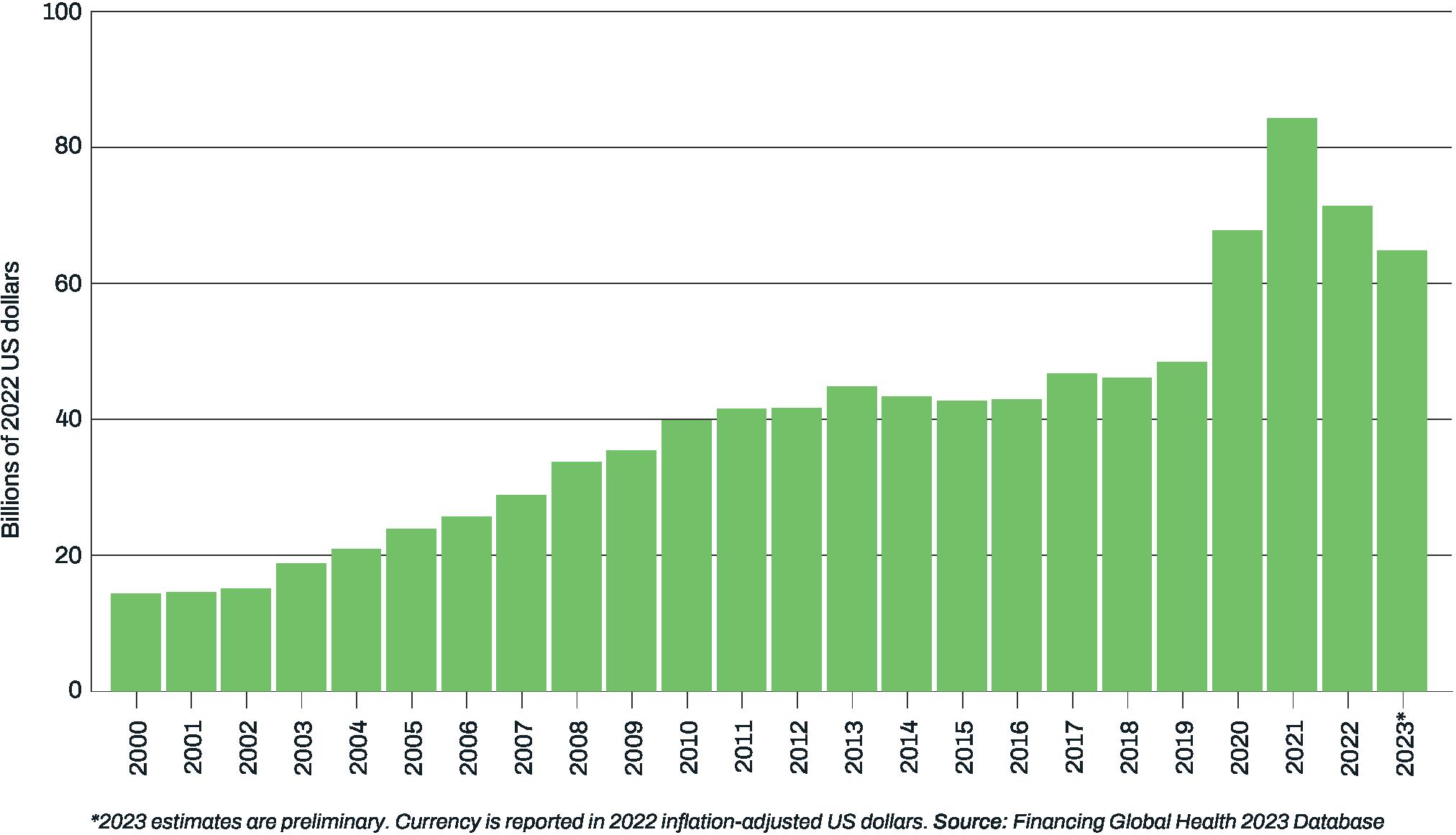
Pressure that development partners are encountering to scale back spending is one reason development assistance for health is declining. For example, during the first year of the COVID-19 pandemic, the UK government announced13 that it would temporarily scale back its development assistance given its own economic crisis sparked by the pandemic. The government of the UK declared that it was reducing its total development assistance budget from 0.7% to 0.5% of gross national income. The UK does not plan to increase its spending on development assistance as a share of income until 2027 or 202813 at the earliest. Also, many development partners have scaled back development assistance for health in response to WHO declaring the end of the COVID-19 public health emergency in 2023. Injecting further uncertainty into the future of development assistance for health are doubts surrounding funding from the US, the largest health development partner. For example, at the time of writing, the future of the US-funded President’s Emergency Plan for AIDS Relief (PEPFAR) was uncertain.14 The US invested approximately $9.5 billion in HIV/AIDS in 2022, which represented 13.4% of total development assistance for health.
Another factor that is reducing development assistance for health is development partners’ shifting priorities. Increasingly, donor countries are challenged to prioritize other sectors over health, such as combating and adapting to climate change, and helping Ukraine repel Russia’s invasion. Figure 5 demonstrates how the share of development assistance devoted to health relative to other sectors has changed since 2000. Development partners’ giving to health has fluctuated over time, rising to 11.1% of total commitments in 2015, then dropping to 8.6% by 2019. Driven by development assistance for the COVID-19 pandemic, the percentage of commitments allocated to health reached a record high in 2021 of 16.2%. In 2022, however, the percentage of total commitments for health shrank back to 10.3%, a drop of 36.4%. Overall, a relatively small fraction of development assistance targets the health sector.
Figure 5 Development assistance: commitments to health and to other sectors, 2000–2022

Given economic pressure, competing priorities influencing development partners, and an expected return to pre-COVID spending levels, IHME forecasts two potential future scenarios (Figure 6). If development partners continue to prioritize health, IHME predicts that development assistance for health will increase by 4.9% ($2.4 billion) between 2019 and 2030. However, if development partners shift funding to other sectors and away from health, development assistance for health could decline by 23.9% ($11.5 billion) from 2019 to 2030.
If a country’s government reduces its health spending to pay off debt and development partners cut development assistance for health, individuals in these countries might be compelled to pay for their own health care or forgo needed health services.
IHME forecasts that total health spending per person will remain flat or even drop between 2019 and 2030 in some of the most vulnerable countries in the world (Figure 7). Many of these countries face both the highest burden of disease15 and the fastest population growth,16 such as countries in Central and Eastern Africa.

Figure 7 Total health spending per person, annual rate of change, 2019–2030

IHME’s research suggests that development assistance for health reached a historic high of $84.0 billion in 2021 but dropped to $64.6 billion in 2023, a reduction of $19.4 billion (Figure 8). Still, in 2023, IHME’s preliminary estimates indicate that development assistance for health remained substantially larger than it was before the pandemic – it was $48.3 billion in 2019.
Figure 8 shows where development assistance for health originates, such as government treasuries and private philanthropy. This is also known as the source of funding. The largest amount of development assistance comes from country governments. Figure 8 shows that US funding increased between 2021 and 2023 from $19.1 billion to $20.6 billion, a 7.8% increase, according to IHME’s preliminary findings. Development assistance for health from Japan grew by 16.3% between 2021 and 2022, but IHME estimates that it then dropped by 45.2%, totaling $2.0 billion in 2023. Similarly, IHME estimates that the amount of development assistance for health provided by many governments fell after 2021, such as Germany, France, Canada, and China. Funding from the UK peaked earlier, in 2020, at $6.0 billion, and decreased to $3.7 billion by 2023.
Figure 8 also reveals continuing support from the private sector between 2021 and 2023. Funding from the Bill & Melinda Gates Foundation, corporate donations, and other private philanthropy stayed relatively steady, representing $13.0 billion in 2021 and $12.3 billion in 2023.
Sources: The origins of funding, such as government treasuries, private philanthropic foundations, or any private-party contributions.
Disbursing entities: The intermediaries in the flow of funds, disbursing entities include bilateral aid agencies, multilateral organizations, non-governmental organizations (NGOs), UN agencies, public-private partnerships, and private foundations.
Health focus areas: The health focus areas assessed in this report are malaria; HIV/AIDS; tuberculosis; reproductive, maternal, newborn, and child health; non-communicable diseases; other infectious diseases; and health systems strengthening (HSS) and sectorwide approaches (SWAPS). “Other DAH” refers to resources that target issues outside these focus areas, and “unallocable” captures the resources that we do not have information to assign.
Figure 8 Development assistance for health and COVID-19 by source of funding, 1990–2023
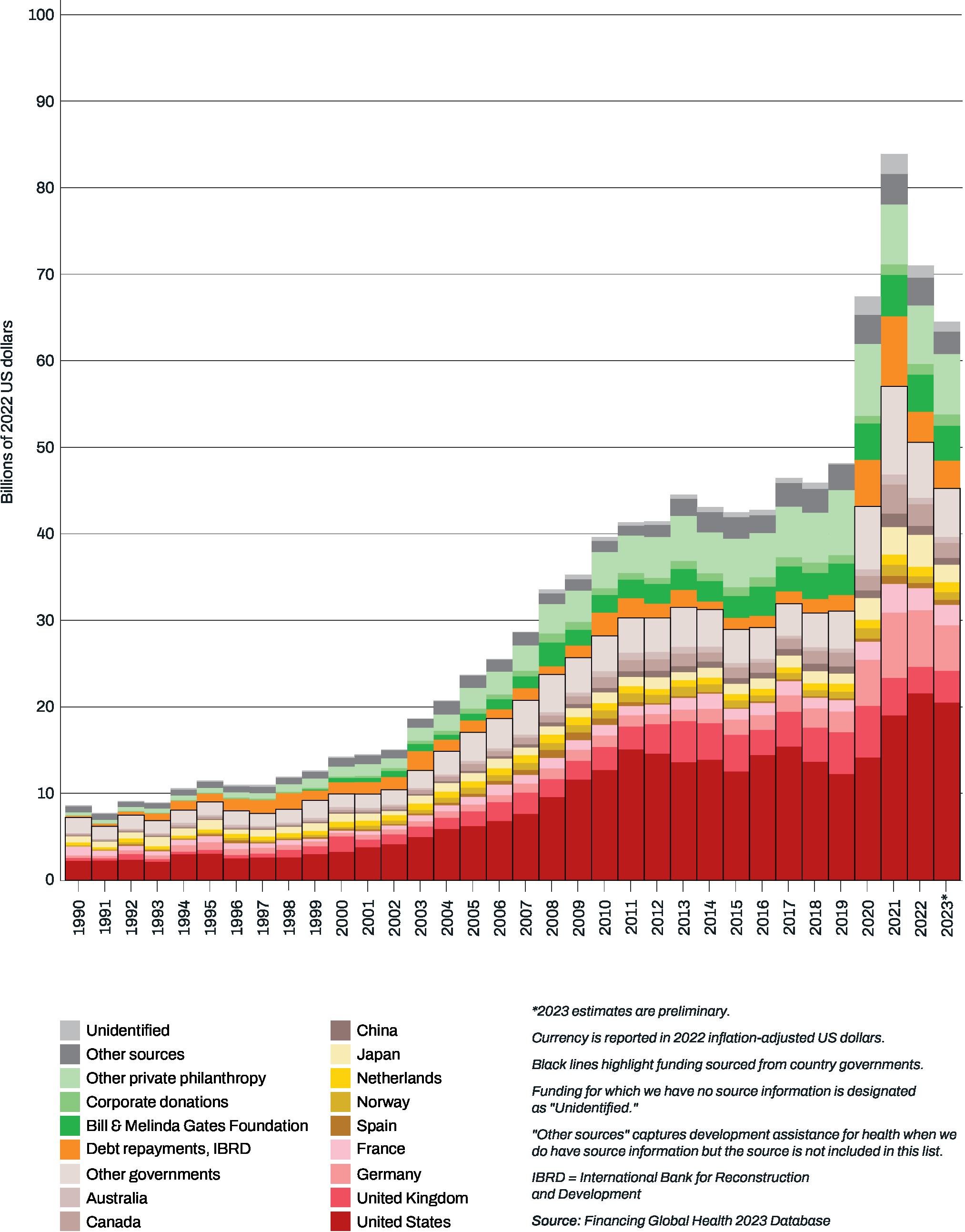
Figure 9 Development assistance for health by disbursing entity, 1990–2023
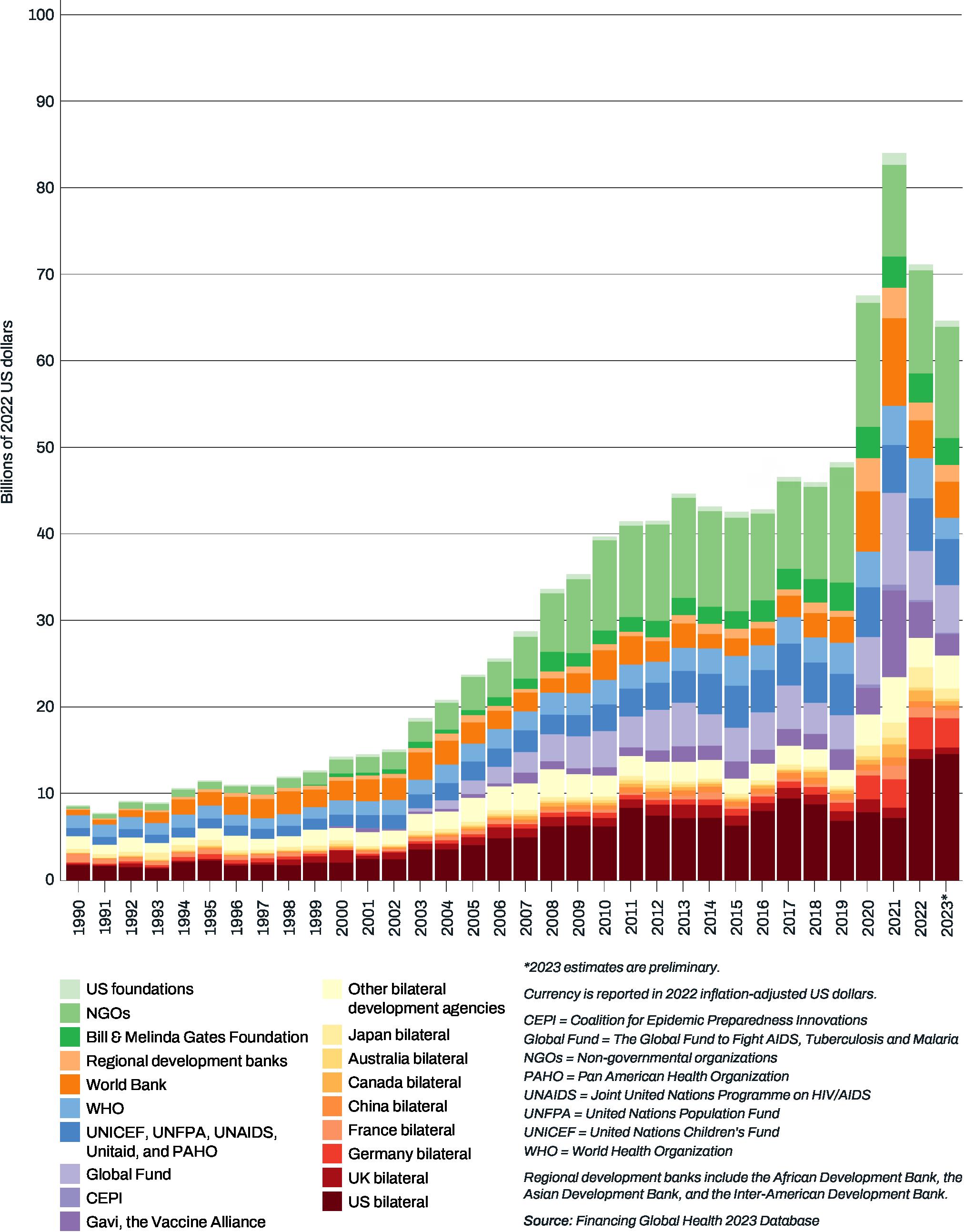
Another way to look at development assistance is by breaking it down by disbursing entity. Among the disbursing entities shown in Figure 9, the amount of funding channeled through the World Bank; Global Fund; and Gavi, the Vaccine Alliance decreased the most between 2021 and 2023 according to IHME’s preliminary estimates. During this period, IHME estimates suggest that development assistance from the World Bank dropped by 58.8%, while spending by the Global Fund and Gavi dropped by 48.2% and 75.1%, respectively. Funding channeled through WHO declined by 46.1% from 2021 to 2023, but development assistance for health coming through other UN agencies combined remained relatively steady, decreasing by only 3.4%. Among bilateral agencies, between 2021 and 2023, funding from the United States’ bilateral agencies grew by 102.5%. Funding disbursed by Germany’s and France’s bilateral agencies dropped slightly between 2021 and 2023, shrinking by 11.5%. Development assistance from UK bilateral agencies declined by 36.9%, and funding from Japanese bilateral agencies dropped by 32.5%, largely due to a decline in funding for COVID-19. Looking at private development partners, financing from the Bill & Melinda Gates Foundation remained steady, at $3.6 billion in 2021 and $3.1 billion in 2023, but funding from other US foundations shrank by 48.2% over this period. Development assistance for health disbursed by US NGOs grew between 2021 and 2023 from $8.3 billion to $10.1 billion.
Figure 10 provides additional perspective into development assistance for health, showing the different health focus areas to which it flows. Before COVID-19 arrived, HIV/AIDS was the health focus area that attracted the most money. Funding for COVID-19, included in the “COVID-19 and other infectious diseases” category, far exceeded funding for HIV/AIDS at the height of the pandemic – development assistance for COVID-19 was 4.3 times the size of development assistance for HIV/AIDS in 2021. By 2023, however, development assistance for COVID-19 had decreased by 68.6% to $12.4 billion, which was roughly similar to funding for HIV/AIDS that same year. During this time period, funding for pandemic preparedness, included within the “health systems strengthening/sector-wide approaches” category, also contracted, dropping 43.6% between its peak in 2020 and 2023.
The figure shows how development partners’ support for HIV/AIDS gained momentum as the COVID-19 pandemic ended. While development assistance for HIV/AIDS dropped slightly by 11.7% between 2020 and 2021, it increased by a total of $4.9 billion (53.7%) from 2021 to 2023. Figure 10 also demonstrates continued enthusiasm among development partners for funding newborn and child health, which expanded between 2022 and 2023 by 6.2%, after increasing by 6.4% the previous year.
From 2021 to 2023, funding for reproductive and maternal health, malaria, and tuberculosis increased as well. Changes in development assistance for health for these health focus areas ranged from 11.0% to 17.1% during this period.
In contrast, development assistance for non-communicable diseases shrank by 2.2% between 2021 and 2023. Non-communicable diseases account for 52.0% of all healthy years lost in low- and middle-income countries but constituted less than 4.0% of development assistance for health each year.15
Figure 10 Development assistance for health by health focus area, 1990–2023

Despite the COVID-19 pandemic, the world has made historic progress in improving health since 1950. People are living longer than ever before, and child mortality has reached record lows.1 Spending on health by governments and development partners has played a key role in this success. Now, however, as low-, middle-, and high-income countries continue to recover from the financial fallout of the COVID-19 pandemic, investments in health are at risk.
Countries around the world are paying back the loans that they took out during the COVID-19 pandemic. These loans were essential for sustaining economies, funding overwhelmed health systems, and administering lifesaving COVID vaccines. Unfortunately, the costs of repaying these loans have skyrocketed due to rising interest rates. Low-income countries, which have the lowest health budgets, are especially vulnerable in the face of these economic pressures.
Development partners’ spending on improving health in low- and middleincome countries – development assistance for health – has dropped since reaching an all-time high in 2021, further straining these countries’ health budgets. In addition, competing priorities, such as climate change, could further reduce development assistance for health.
The profound health gains of past decades demonstrate the need for country governments and development partners alike to continue to prioritize health spending. Also, investing in health spurs economic growth since healthier people can work more, earn more, and spend more money.
Enhanced funding for health is vital as the world faces considerable challenges. The health and financial losses caused by the COVID-19 pandemic highlight the need for continued support and advocacy for pandemic preparedness. In addition, millions of children and adults die each year from diseases that are either preventable or treatable.1 Funding for global health remains as urgent as ever.
Source for all figures: Financing Global Health 2023 Database
• Development assistance for HIV/AIDS increased by $4.9 billion (53.7%) between 2021 and 2023 and represented the second-largest share of development assistance for health (21.8%) compared to other health focus areas.
• Countries in Southern sub-Saharan Africa receive the most development assistance for health for HIV/AIDS per person.
• Human resources for HIV/AIDS makes up the largest program area.
Funding for HIV/AIDS reached an all-time high of $14.1 billion in 2023.
Figure A Development assistance for health for HIV/AIDS, 1990–2023
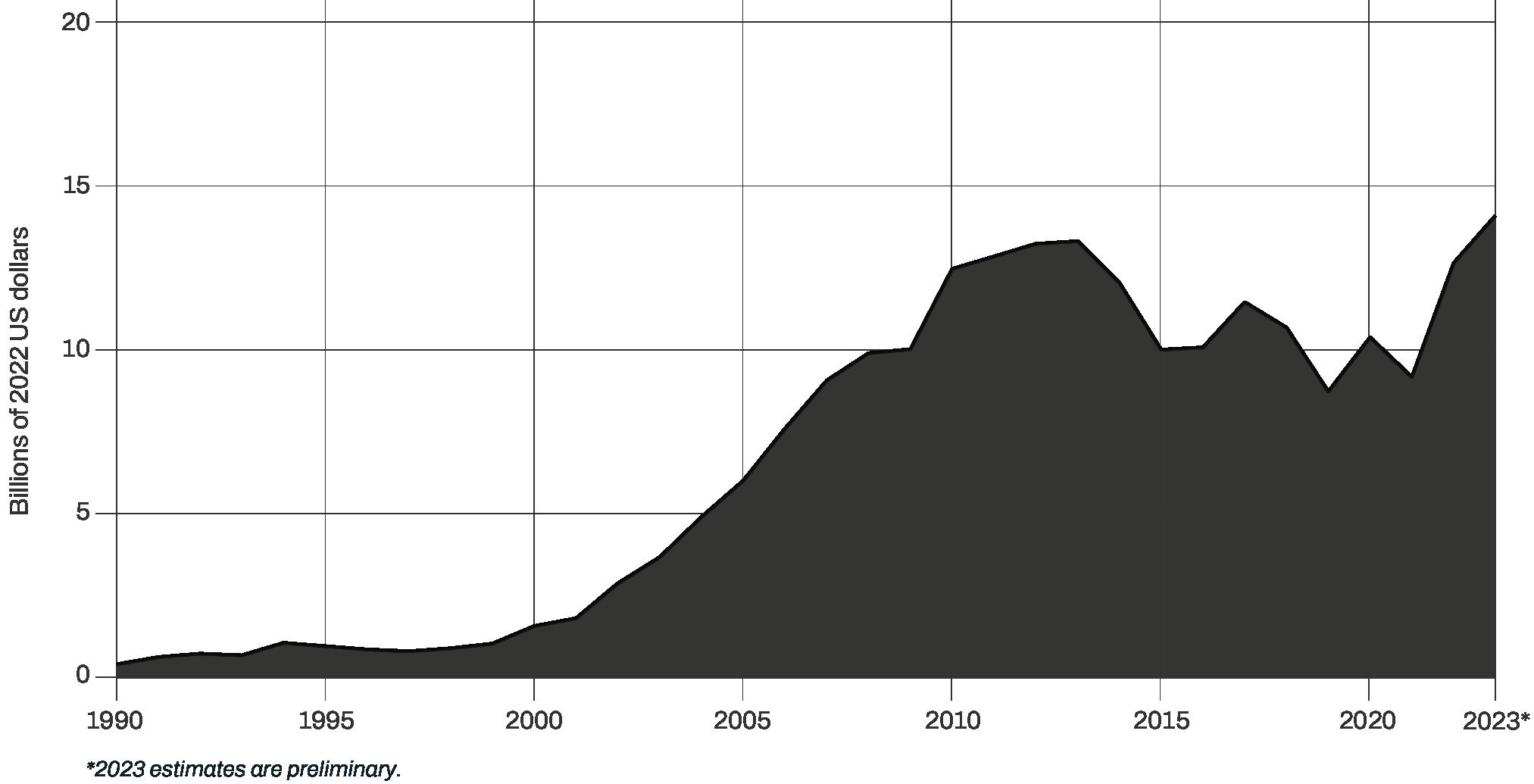
Values are in 2022 USD.
Global Fund = The Global Fund to Fight AIDS, Tuberculosis and Malaria
NGOs = Non-governmental organizations
Other UN Agencies = PAHO, UNFPA, UNICEF, Unitaid, and UNAIDS.
PMTCT = Prevention of mother-to-child transmission
WHO = World Health Organization
Regional development banks include the African Development Bank, the Asian Development Bank, and the Inter-American Development Bank.
Eswatini, Lesotho, and Namibia received the most development assistance for health for HIV/AIDS per person.
Figure B Development assistance for health received per person for HIV/AIDS, 2022

$5.3 billion was spent on human resources for HIV/AIDS in 2023, and $1.8 billion was spent on treatment for HIV/AIDS in 2023, with most funding coming from the United States.
Figure C Flows of development assistance for health for HIV/AIDS, 2023
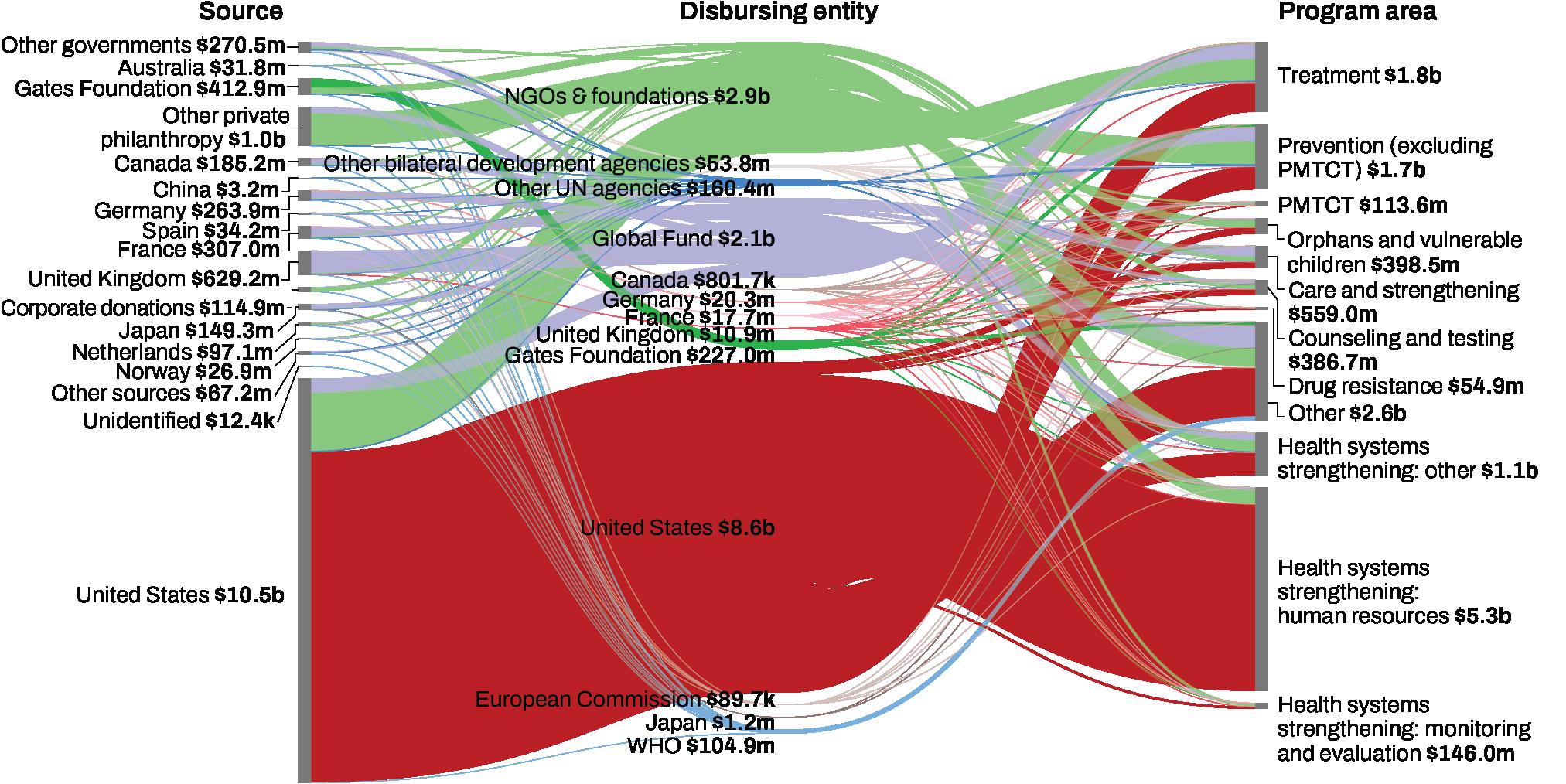
Highlights:
• Since 2016, development assistance for malaria has fluctuated between $2.5 and $3.3 billion, representing 5.4% of total development assistance for health on average.
• Western sub-Saharan Africa has the highest burden of disease from malaria in the world, but other African regions received more development assistance for malaria per person.
• The majority of development assistance for malaria is channeled through the Global Fund, NGOs and foundations, and the US government.
After decreasing by 17.9% between 2017 and 2018, development assistance for malaria rebounded to $3.3 billion in 2023.
Figure A Development assistance for health for malaria, 1990–2023

Values are in 2022 USD.
Global Fund = The Global Fund to Fight AIDS, Tuberculosis and Malaria
NGOs = Non-governmental organizations
Other UN Agencies = PAHO, UNFPA, UNICEF, Unitaid, and UNAIDS.
WHO = World Health Organization
Regional development banks include the African Development Bank, the Asian Development Bank, and the Inter-American Development Bank.
Among countries, São Tomé and Príncipe, Burkina Faso, and Eswatini received the largest amount of funding per person in 2022.
Figure B Development assistance for health received per person for malaria, 2022
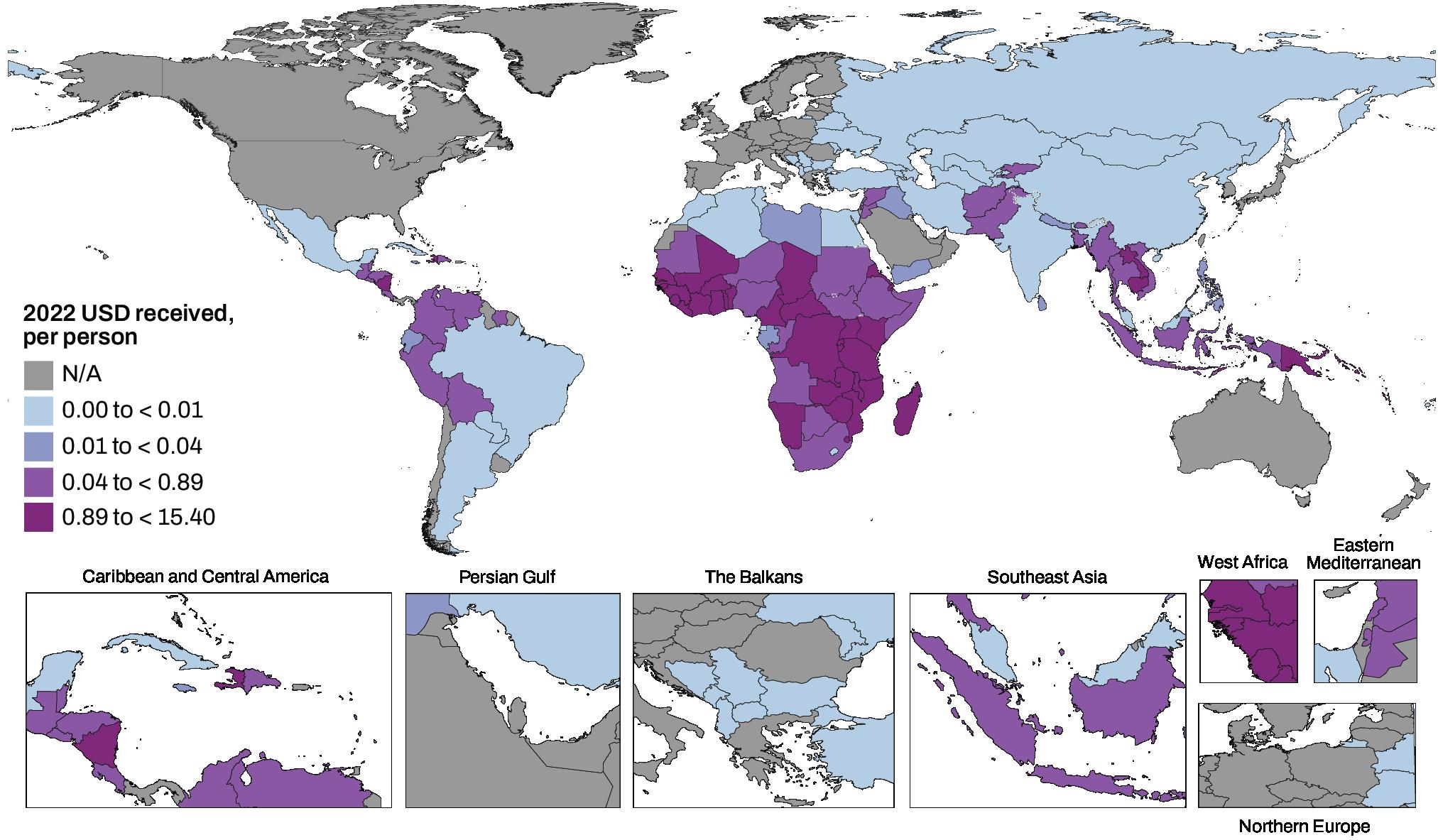
The Global Fund channeled the largest amount of support for malaria treatment in 2023.
Figure C Flows of development assistance for health for malaria, 2023
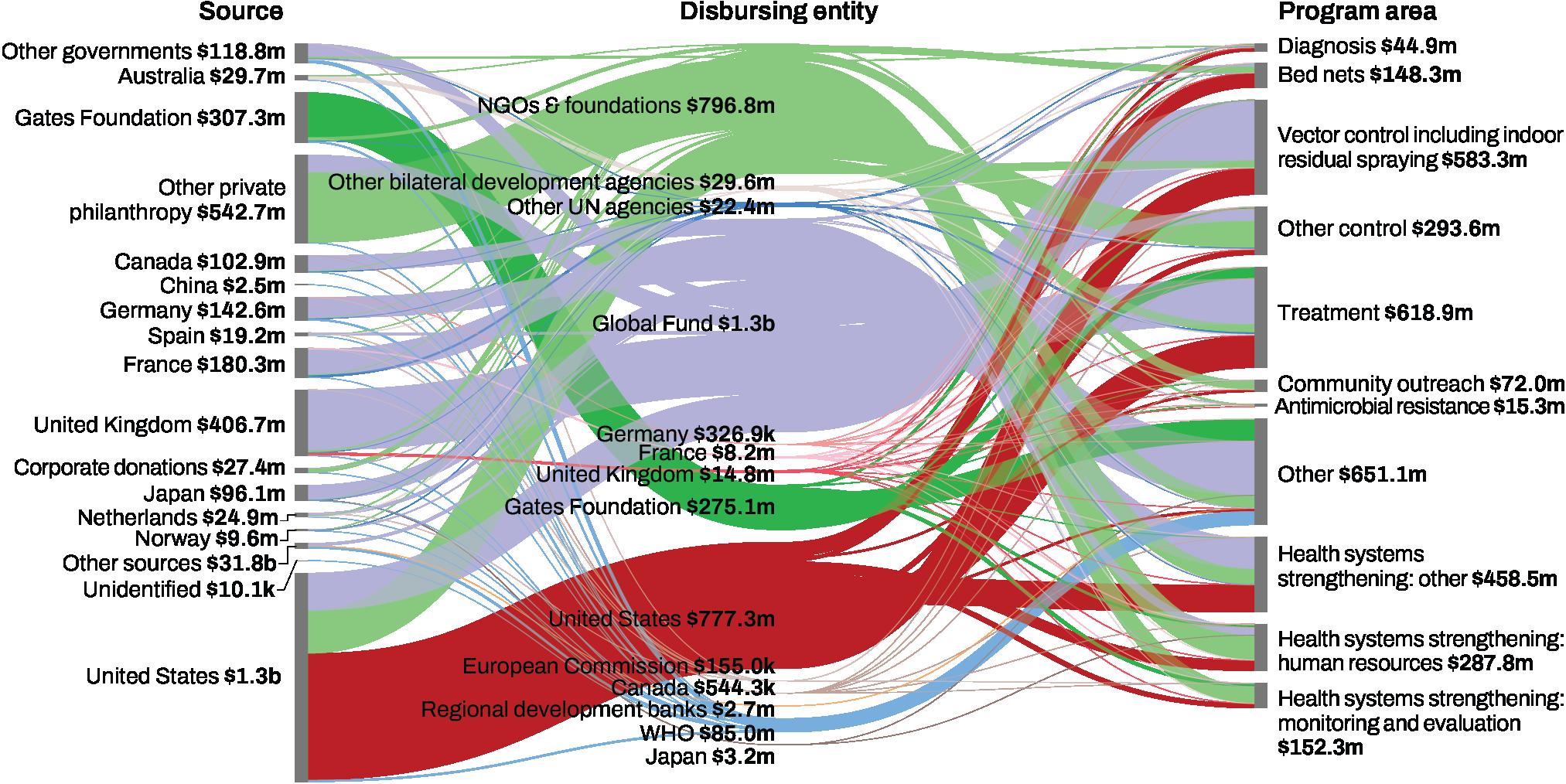
• While development assistance for non-communicable diseases has grown over the past 10 years, it remains a small percentage of total development assistance (less than 2.1% in 2022).
• Development assistance for non-communicable diseases flows largely to countries in sub-Saharan Africa.
• NGOs and foundations, who channel the largest amount of funding for non-communicable diseases, were a major disbursing agency of funding for human resources for non-communicable diseases and mental health programs in 2023.
Development assistance for non-communicable diseases dropped by 34.4% between 2020 and 2023.
Figure A Development assistance for health for non-communicable diseases, 1990–2023
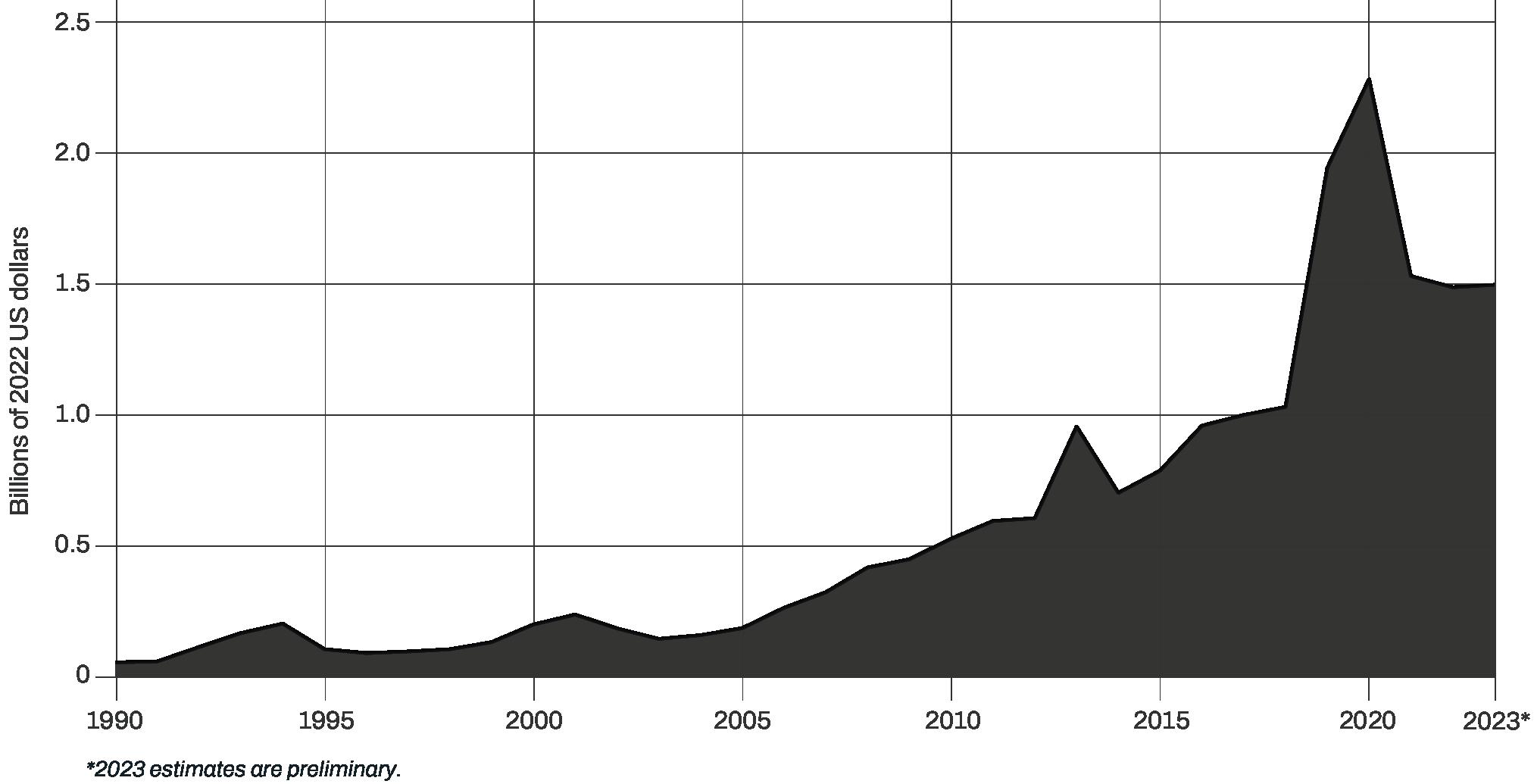
Values are in 2022 USD.
Global Fund = The Global Fund to Fight AIDS, Tuberculosis and Malaria
NGOs = Non-governmental organizations
Other UN Agencies = PAHO, UNFPA, UNICEF, Unitaid, and UNAIDS.
WHO = World Health Organization
Regional development banks include the African Development Bank, the Asian Development Bank, and the Inter-American Development Bank.
At the country level, development assistance for health for non-communicable diseases flowed predominantly to countries in Eastern and Western sub-Saharan Africa.
Figure B Development assistance for health received per person for non-communicable diseases, 2022
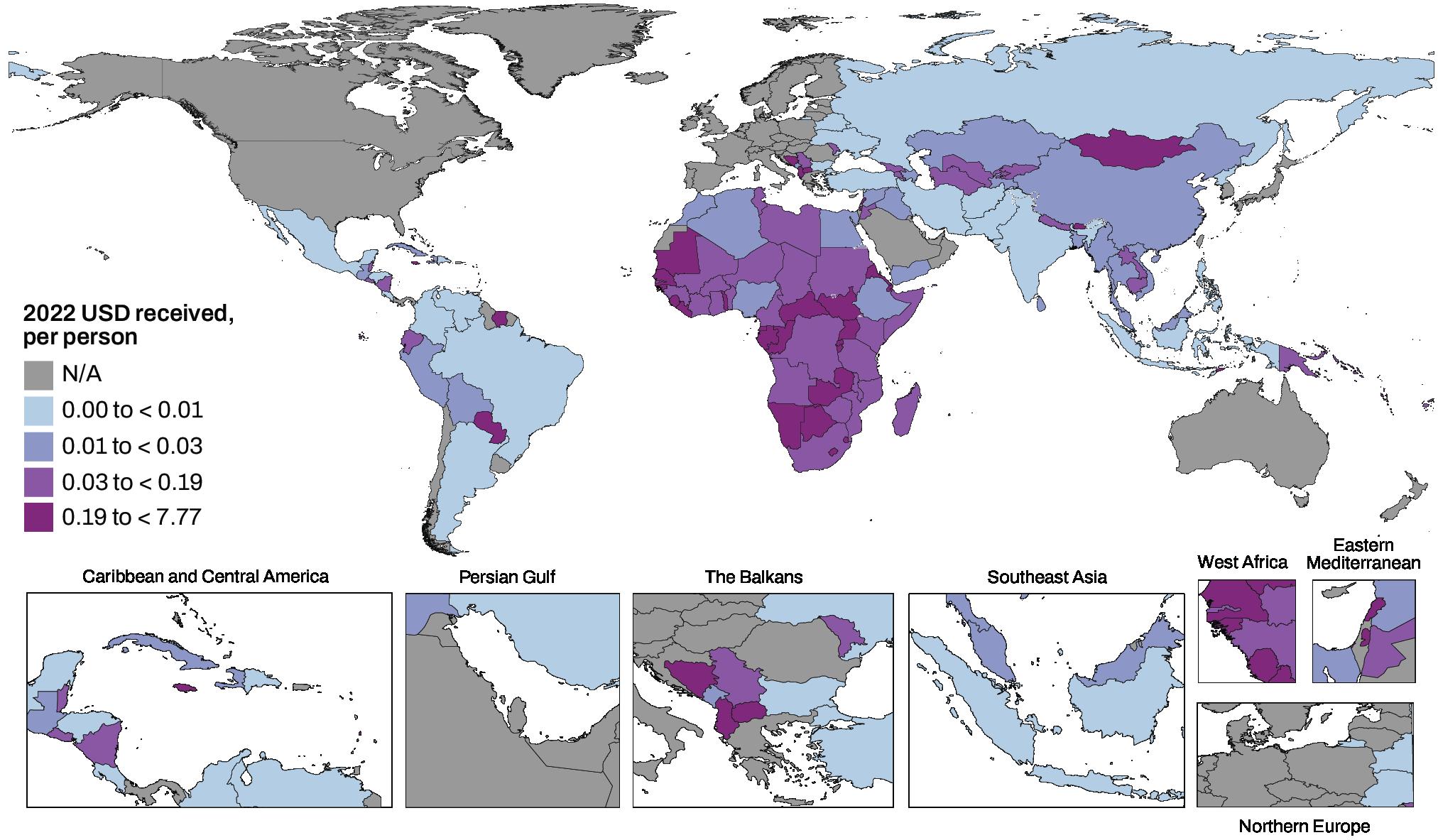
NGOs and foundations channeled the largest amounts of development assistance for non-communicable diseases in 2023.
Figure C Flows of development assistance for health for non-communicable diseases, 2023
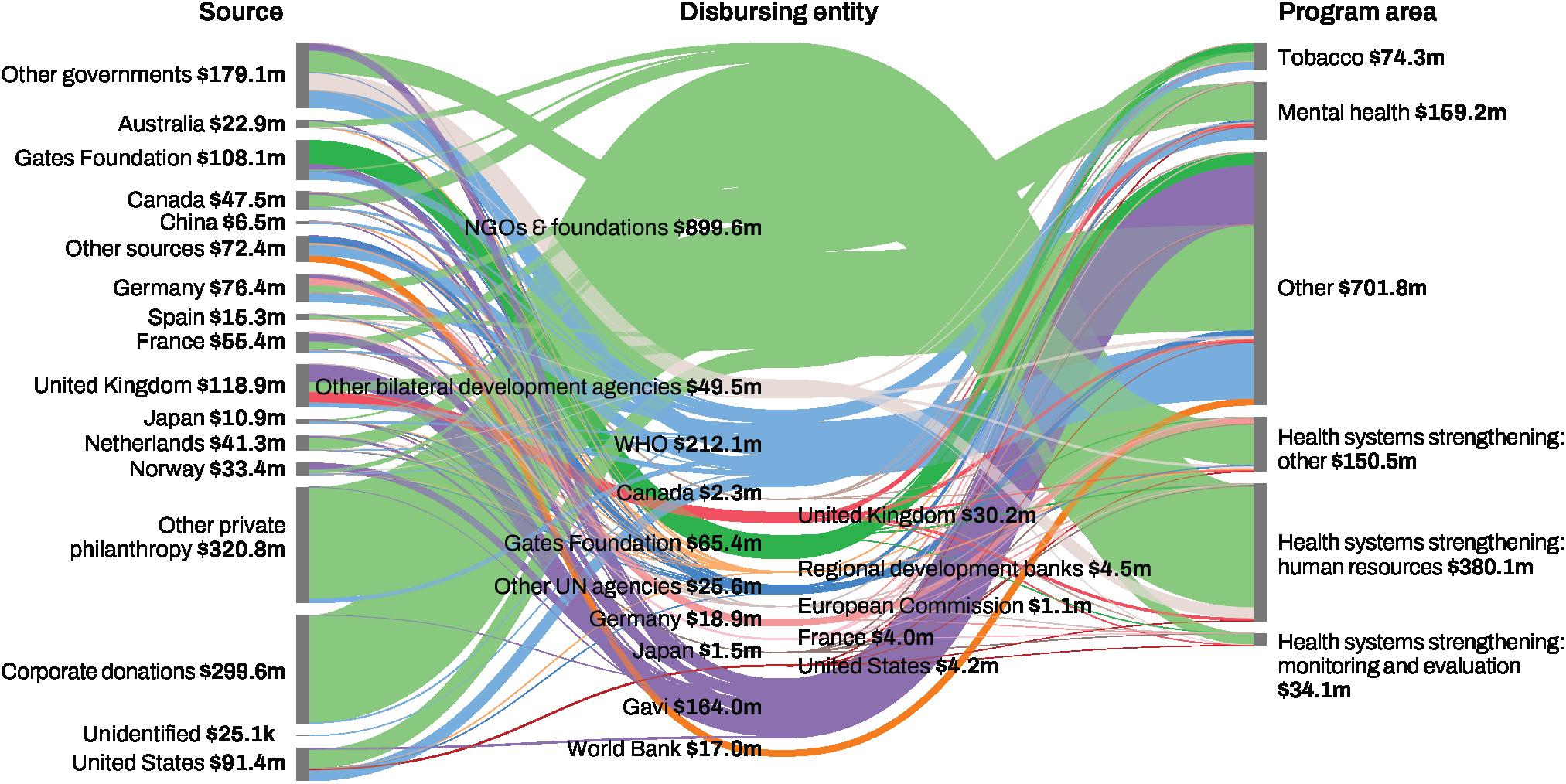
Highlights:
• Development assistance for reproductive, maternal, newborn, and child health dropped between 2019 and 2021, but increased in 2022 and 2023.
• The countries that received the most funding for reproductive, maternal, newborn, and child health in 2022 were located in sub-Saharan Africa and South Asia.
• NGOs and foundations, Gavi, and UN agencies channeled the largest sums of development assistance for reproductive, maternal, newborn, and child health.
Over the last decade, development assistance for health for reproductive, maternal, newborn, and child health has grown by nearly $2.5 billion, an 18.2% increase.
Figure A Development assistance for health for reproductive, maternal, newborn, and child health, 1990–2023
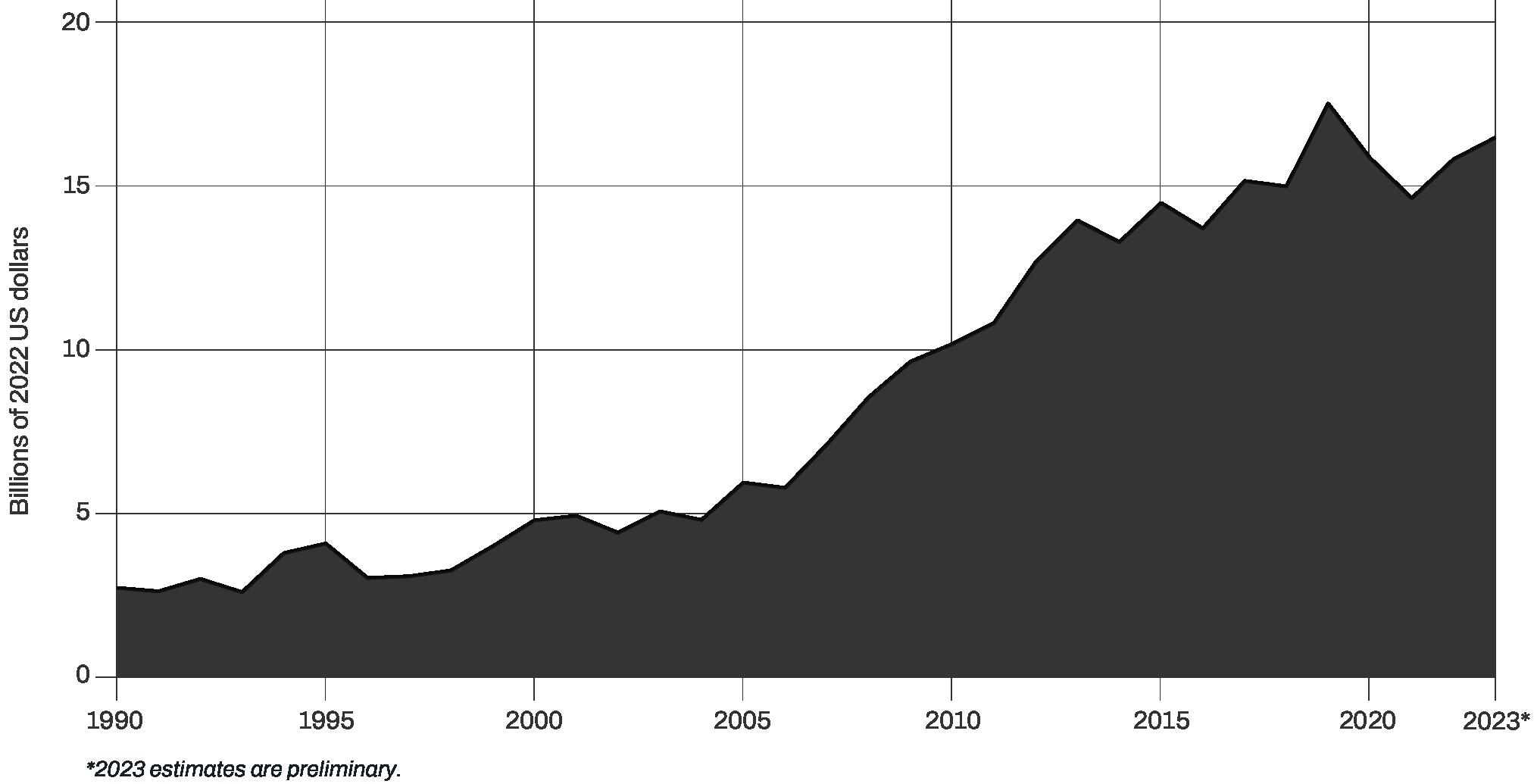
Values are in 2022 USD.
Global Fund = The Global Fund to Fight AIDS, Tuberculosis and Malaria
NGOs = Non-governmental organizations
Other UN Agencies = PAHO, UNFPA, UNICEF, Unitaid, and UNAIDS.
WHO = World Health Organization
Regional development banks include the African Development Bank, the Asian Development Bank, and the Inter-American Development Bank.
In 2022, South Sudan, Kiribati, and São Tomé and Príncipe received the most funding for reproductive, maternal, newborn, and child health per person.
Figure B Development assistance for health received per person for reproductive, maternal, newborn, and child health, 2022

Immunization and nutrition were two of the largest program areas funded by development assistance for reproductive, maternal, newborn, and child health.
Figure C Flows of development assistance for health for reproductive, maternal, newborn, and child health, 2023
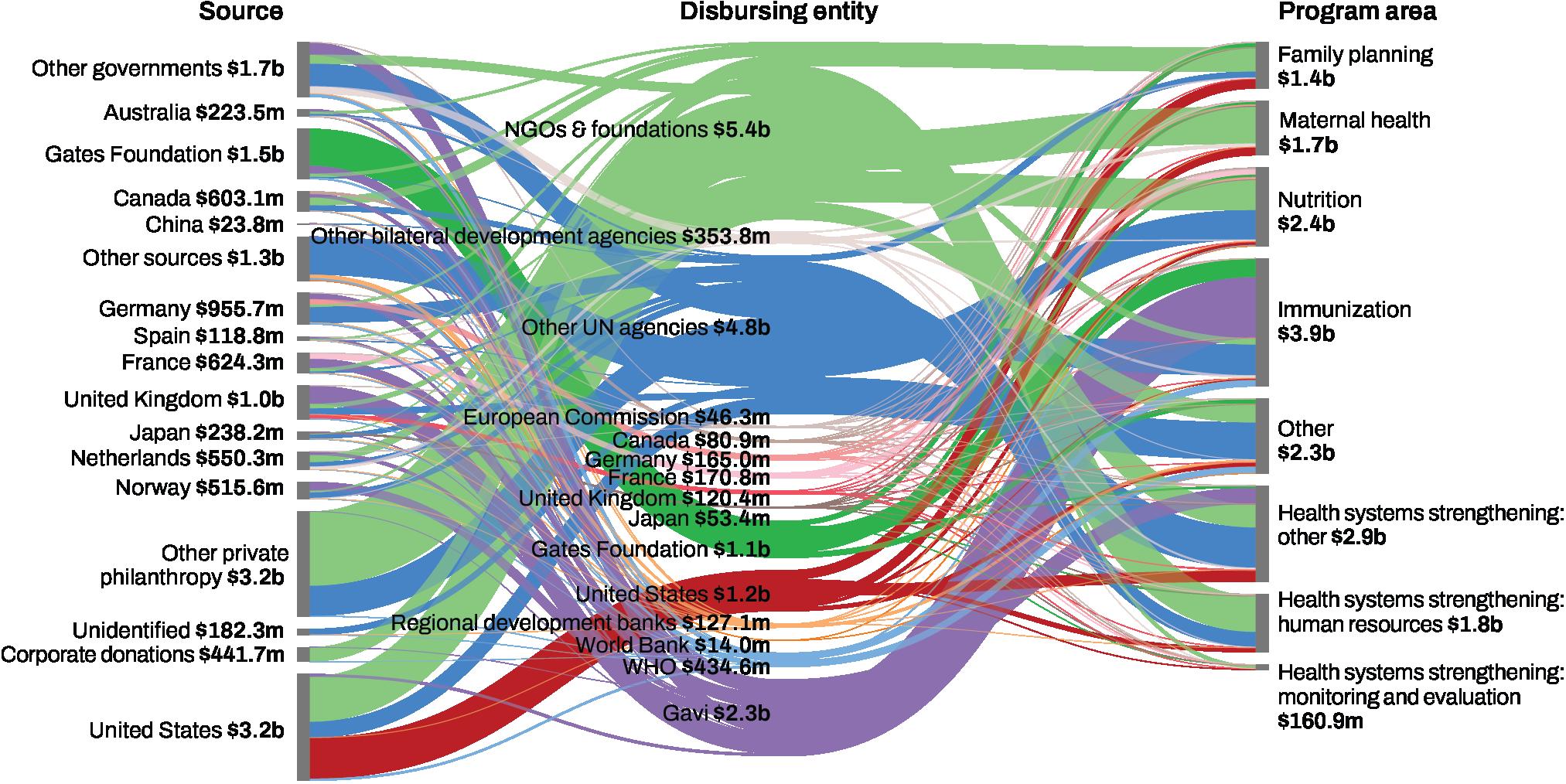
• Development partner contributions to pandemic preparedness and response increased rapidly amid the pandemic, reaching a high in 2020, yet remained a small share of total development assistance overall (less than 1%) that year.
• Development assistance for pandemic preparedness and response came from a variety of sources, the largest single sources being the United States, Germany, and the Bill & Melinda Gates Foundation.
• UN agencies, most notably the World Health Organization, play a dominant role in distributing development assistance for pandemic preparedness and response.
Development assistance for pandemic preparedness and response peaked in 2020 at over $1 billion.
Figure A Development assistance for health for pandemic preparedness and response, 1990–2023
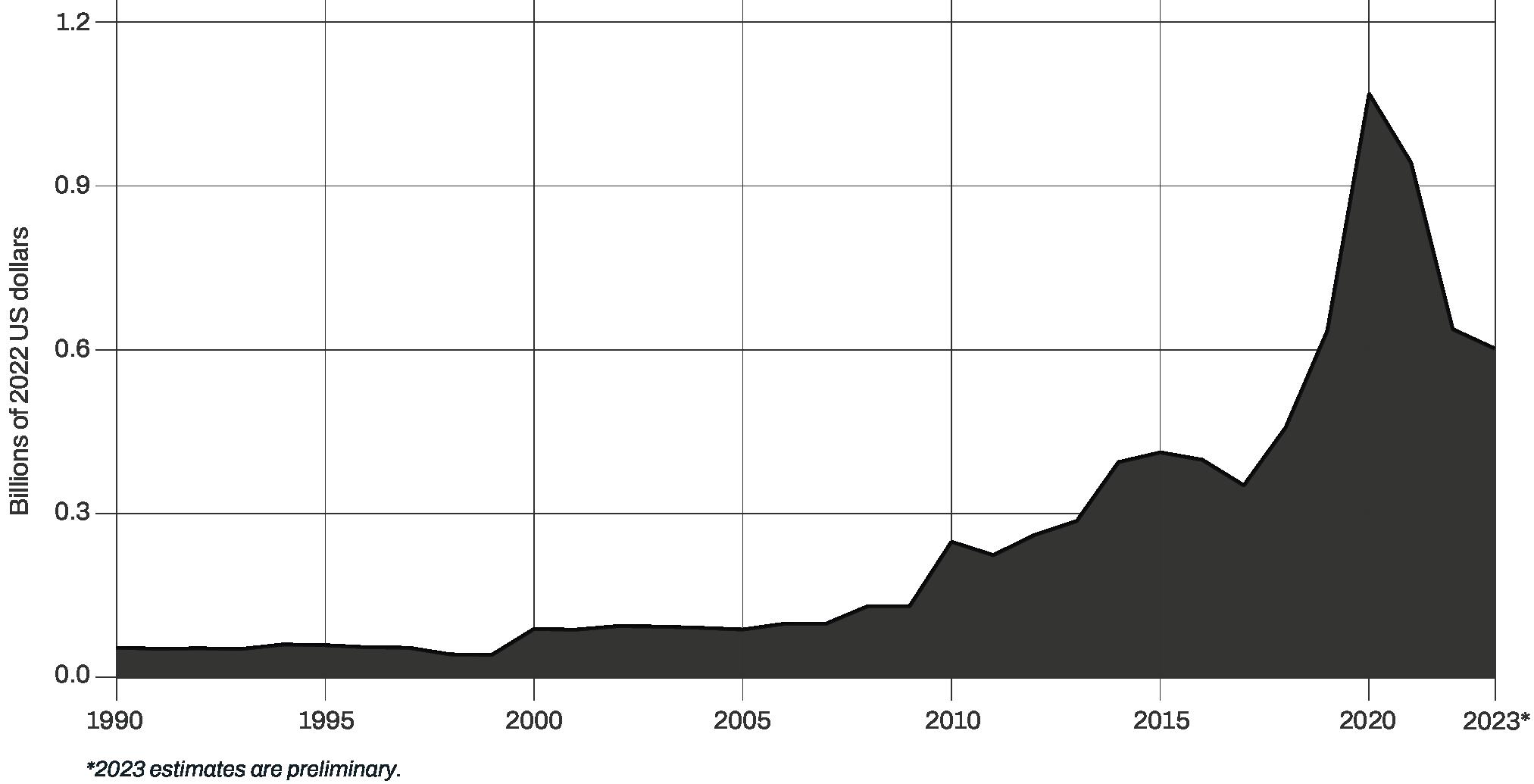
Values are in 2022 USD.
Global Fund = The Global Fund to Fight AIDS, Tuberculosis and Malaria
NGOs = Non-governmental organizations
Other UN Agencies = PAHO, UNFPA, UNICEF, Unitaid, and UNAIDS.
WHO = World Health Organization
Regional development banks include the African Development Bank, the Asian Development Bank, and the Inter-American Development Bank.
The development assistance for pandemic preparedness that was distributed at the country level flowed primarily to countries in sub-Saharan Africa.
Figure B Development assistance for health received per person for pandemic preparedness and response, 2022

In 2023, most financing for pandemic preparedness and response was distributed by UN agencies, including the World Health Organization and the Pan American Health Organization (PAHO), and the Coalition for Epidemic Preparedness Innovations (CEPI).
Figure C Flows of development assistance for health for pandemic preparedness and response, 2023
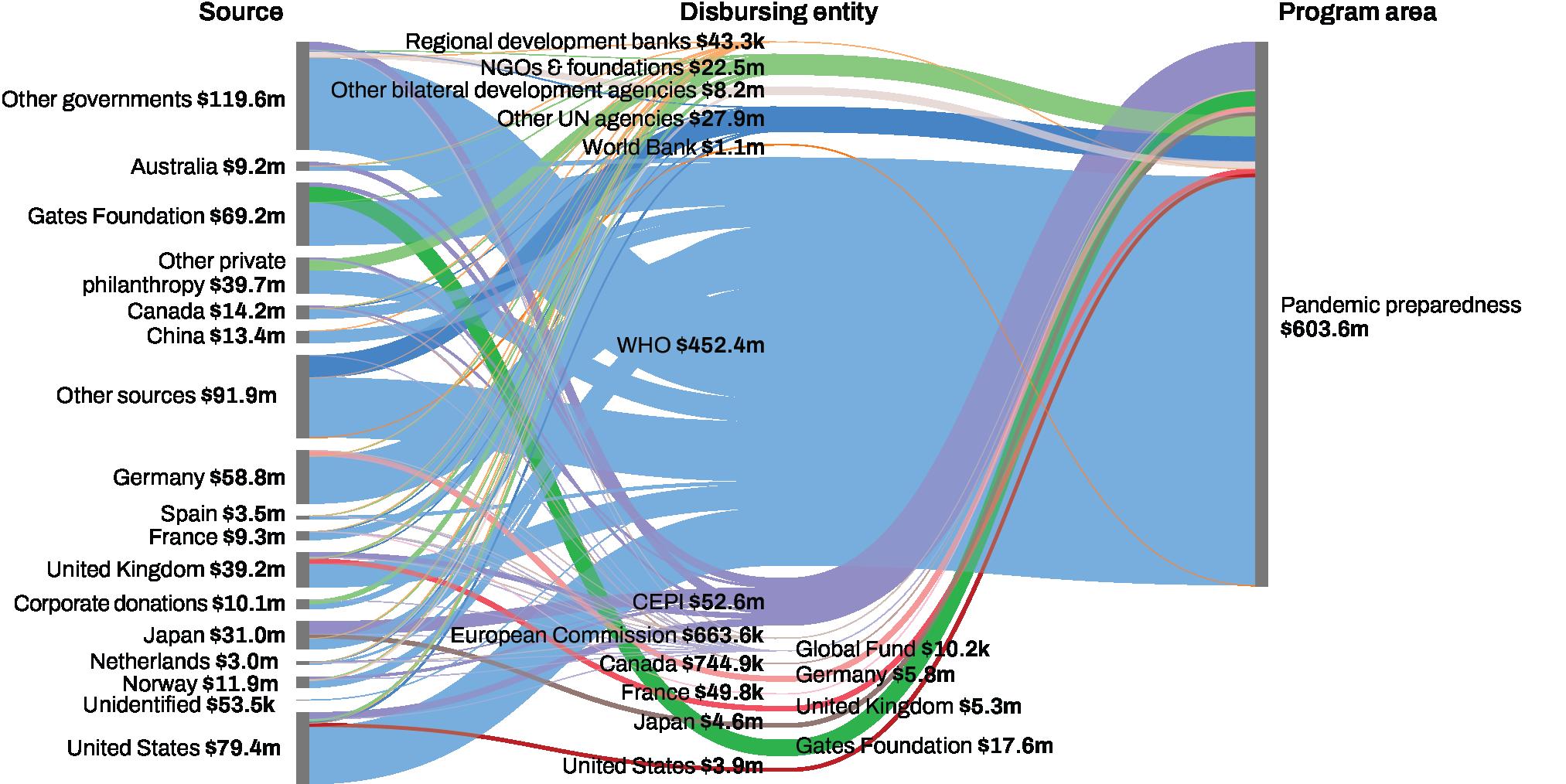
• In 2022, development assistance for tuberculosis reached a high of $2.6 billion, similar to levels last seen in 2017.
• Development assistance for tuberculosis was concentrated primarily among countries in Southern and Central sub-Saharan Africa and Central and East Asia.
• The US government was the largest source of development assistance for tuberculosis.
Development assistance for tuberculosis dropped by 3.3% between 2017 and 2021, but rose again in 2022 to $2.6 billion, remaining relatively steady in 2023.
Figure A Development assistance for health for tuberculosis, 1990–2023
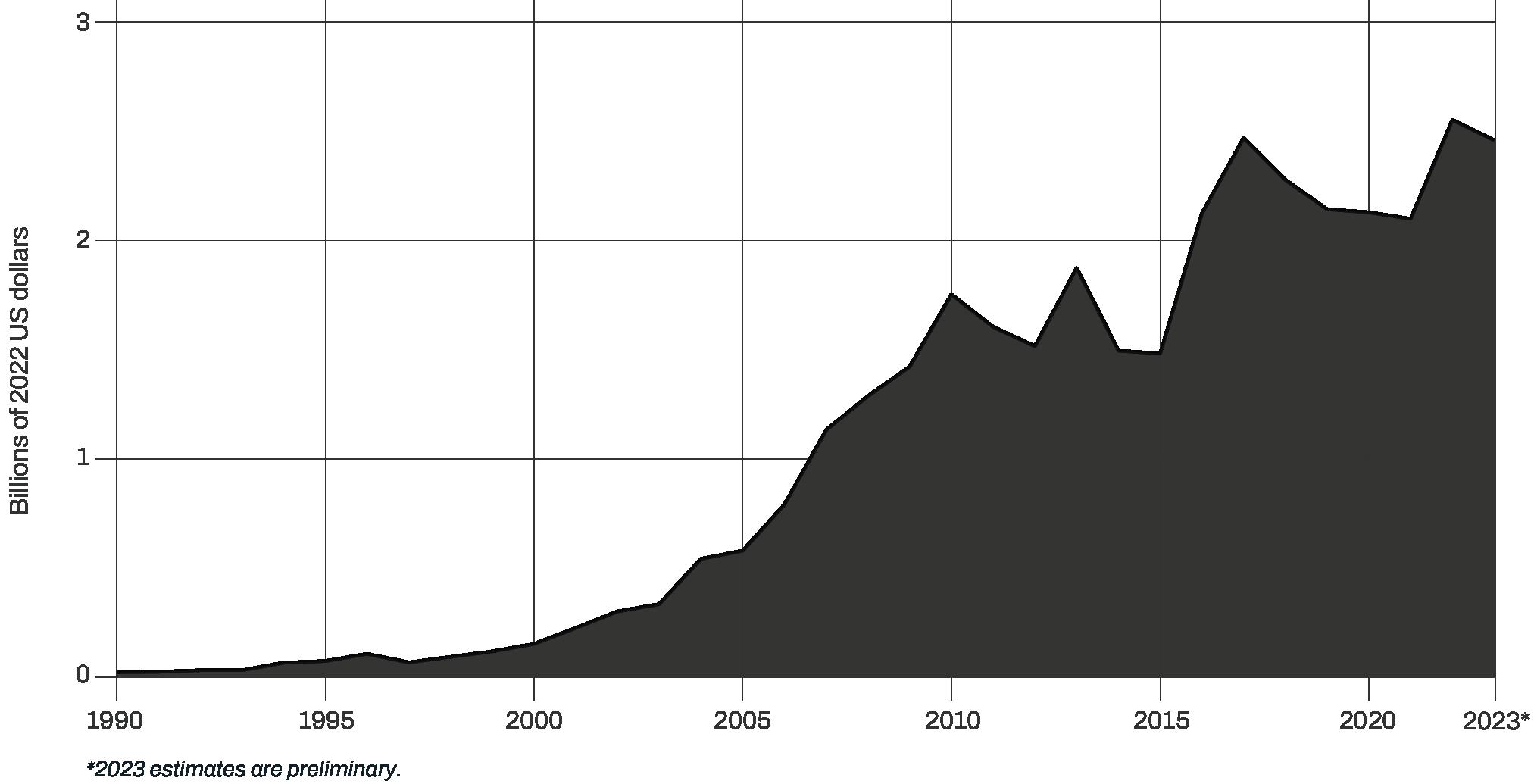
Values are in 2022 USD.
Global Fund = The Global Fund to Fight AIDS, Tuberculosis and Malaria
NGOs = Non-governmental organizations
Other UN Agencies = PAHO, UNFPA, UNICEF, Unitaid, and UNAIDS.
WHO = World Health Organization
Regional development banks include the African Development Bank, the Asian Development Bank, and the Inter-American Development Bank.
São Tomé and Príncipe, Dominica, and Lesotho received the largest amounts of development assistance for tuberculosis per person in 2022.
Figure B Development assistance for health received per person for tuberculosis, 2022
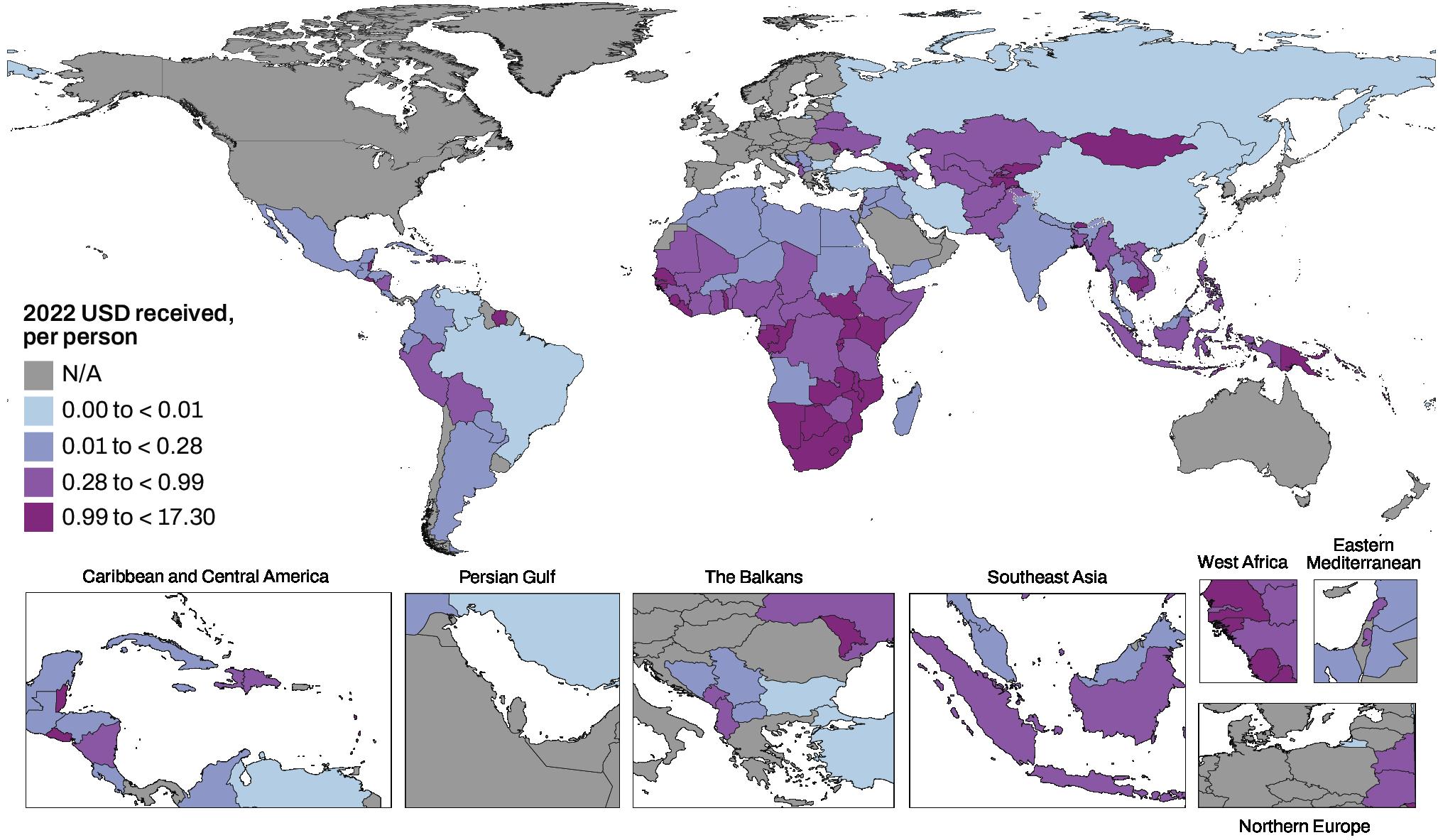
Most development assistance for tuberculosis flowed through the Global Fund.
Figure C Flows of development assistance for health for tuberculosis, 2023

1. Schumacher AE, Kyu HH, Aali A, et al. Global age-sex-specific mortality, life expectancy, and population estimates in 204 countries and territories and 811 subnational locations, 1950–2021, and the impact of the COVID-19 pandemic: a comprehensive demographic analysis for the Global Burden of Disease Study 2021. The Lancet 2024; 0. DOI:10.1016/S01406736(24)00476-8.
2. OECD Statistics. https://stats. oecd.org/ (accessed April 18, 2024).
3. Cohen P. Crisis and Bailout: The Tortuous Cycle Stalking Nations in Debt. The New York Times. 2023; published online Sept 18. https://www.nytimes. com/2023/09/18/business/ economy/ghana-debt-imf.html (accessed April 15, 2024).
4. Hovet J. In Czech election, the prize is one of EU’s fastestgrowing debt burdens. Reuters. 2021; published online Oct 5. https://www.reuters.com/world/ europe/czech-election-prize-isone-eus-fastest-growing-debtburdens-2021-10-05/ (accessed April 16, 2024).
5. Higher-for-Longer Interest Rate Environment is Squeezing More Borrowers. IMF. 2023; published online Oct 10. https://www.imf.org/en/Blogs/ Articles/2023/10/10/higher-forlonger-interest-rate-environmentis-squeezing-more-borrowers (accessed April 17, 2024).
6. John M. Global central banks unite in ‘higher for longer’ credo. Reuters. 2023; published online Sept 22. https:// www.reuters.com/markets/ rates-bonds/global-centralbanks-unite-higher-longercredo-2023-09-21/ (accessed April 17, 2024).
7. Congressional Research Service. The U.S. Dollar as the World’s Dominant Reserve Currency, 2022. In Focus.
8. Reform Priorities for Tackling Debt. World Bank Live. https://live.worldbank.org/ en/event/2023/2023-annualmeetings-reform-priorities-fortackling-debt (accessed April 15, 2024).
9. In Memoriam of Dr. Naimatou Moussa. Women in Global Health. https://womeningh.org/ resources/in-memoriam-drnaimatou-moussa/ (accessed April 24, 2024).
10. Cancer in Africa, a Financially Devastating Disease | Think Global Health. Council on Foreign Relations. https:// www.thinkglobalhealth.org/ article/cancer-africa-financiallydevastating-disease (accessed April 18, 2024).
11. Jowett M, Brunal MP, Flores G, Cylus J. Spending targets for health: no magic number. DOI:10.13140/ RG.2.2.18243.20006
12. Meheus F, McIntyre D. Fiscal space for domestic funding of health and other social services. Health Econ Policy Law. 2017 Apr;12(2):159-177. doi: 10.1017/ S1744133116000438.
13. Brien P, Loft P. UK aid: Spending reductions since 2020 and outlook from 2023. 2024; published online April 16. https:// commonslibrary.parliament.uk/ research-briefings/cbp-9224/ (accessed April 15, 2024)
14. Why PEPFAR matters, with Dr. Anthony Fauci | Institute for Health Metrics and Evaluation. https://www.healthdata.org/ news-events/podcasts/whypepfar-matters-dr-anthony-fauci (accessed April 16, 2024)
15. Ferrari AJ, Santomauro DF, Aali A, et al. Global incidence, prevalence, years lived with disability (YLDs), disabilityadjusted life-years (DALYs), and healthy life expectancy (HALE) for 371 diseases and injuries in 204 countries and territories and 811 subnational locations, 1990–2021: a systematic analysis for the Global Burden of Disease Study 2021. The Lancet 2024; 0. DOI:10.1016/S01406736(24)00757-8.
16. Bhattacharjee NV, Schumacher AE, Aali A, et al. Global fertility in 204 countries and territories, 1950–2021, with forecasts to 2100: a comprehensive demographic analysis for the Global Burden of Disease Study 2021. The Lancet 2024; 0. DOI:10.1016/S01406736(24)00550-6.
Financing Global Health 2023 reports estimates based on the most reliable and up-to-date data available as of April 2024. Drawing upon data from spending accounts, budgets, and other estimates from a broad set of sources, we employed statistical models and accounting methods to produce our estimates. This section briefly outlines our processes. For detailed information on the input data and methodology, please refer to our online Methods Annex, available at https://bit.ly/FGH23Methods
US interest rates were obtained from the Bank for International Settlements’ “Central bank policy rates” database, which records the midpoint of the Federal Reserve target rate. We pulled daily data from 2010 to 2023 and calculated the annual average.
To analyze changes in country interest payments, IHME used data from the International Monetary Fund’s World Economic Outlook database: October 2023 edition. Interest payments were calculated as General government primary net lending/borrowing Minus General government net lending/borrowing. We pulled data from 2019 to 2028.
IHME compiled financing data from the sources and disbursing entities discussed in this report. The goal was to track disbursements through international development agencies that aimed to maintain or improve health in low- and middle-income countries from 1990 through 2023. In addition to data from international databases such as the Organisation for Economic Cooperation and Development’s Creditor Reporting System, we extracted and harmonized commitment and disbursement data from development project records, annual budgets, annual financial statements, and revenue statements from a broad set of development agencies, including multilateral and bilateral aid agencies, public-private partnerships, NGOs, and private foundations.
Furthermore, for several disbursing agencies, direct correspondence with agencies led to better understanding of the data or to the acquisition of more granular, more reliable, or more timely data. Some organizations were not able to report on disbursements for the previous year because agencies’ accounting processes can be lengthy. We therefore relied on budgets, revenues, commitments, and appropriations, as well as macroeconomic data, to estimate disbursements for organizations without up-to-date spending information, and these were used to model the most recent year’s disbursements. This method led to the development of “preliminary estimates” of DAH by source, channel, and health focus area for 2023. We do not report DAH estimates by recipient for 2023 because preliminary estimates were not made by recipients.
Global health agencies frequently transfer funds among themselves. Since these funding flows are often reported by both the entity from which funds originate and the recipient agency, double-counting occurs in the data. Including disbursements from both agencies would lead to an overestimation of disbursements. To avoid double-counting, we used revenue data to assess the source of all funds and remove resources that were passed between development agencies before being disbursed. For our accounting purposes, the source of the funds is where the funds originated, while the channel is the last disbursing agency that we track to disburse the resources. Because each data source provides different categories and different information about what focus areas were targeted by their disbursements, project-specific sector and theme codes and keyword searches of project titles and descriptions were used to classify funding. All DAH from the Joint United Nations Programme on HIV/ AIDS (UNAIDS) was considered funding for HIV/AIDS and tuberculosis. Funding from UNICEF was classified as DAH for reproductive, maternal, newborn, and child health, HIV/AIDS, and Ebola. For projects that span two or more health focus areas, funding was divided according to weights based on the number of keywords associated with each health focus area. DAH estimates were reported in 2022 US dollars.
We developed a separate methodology for estimating DAH for COVID-19 to better track the rapidly evolving state of health financing during the pandemic. We extracted project data on commitments and disbursements from a diverse set of databases, including the UNOCHA Financial Tracking Service and the International Aid Transparency Initiative. For other development channels, we obtained information about COVID-19 commitments and disbursements through correspondence or from their respective online databases.
We extracted and adjusted health spending data from the World Health Organization Global Health Expenditure Database to estimate total health spending and health spending by source. The variables we extracted include transfers from government domestic revenue (allocated to health purposes), social insurance contributions, compulsory prepayment, voluntary prepayment, other domestic revenue from households, corporations, and nonprofit institutions serving the household. We obtained spending estimates from 2000 to 2021, in current local currency and converted them into 2022 US dollars. We then used a spatiotemporal Gaussian process regression model (ST-GPR) to estimate health spending for all years, countries, and spending categories. This model also allowed us to generate 500 draws for each datapoint, to reflect the uncertainty associated with this data.
Additionally, we prioritized data from the Global Health Expenditure Database that had the most credible sources and with the best documentation for our ST-GPR modeling. Our method used a natural language processing model to evaluate and assign a weight to each datapoint based on the metadata describing the source and methods used to estimate those values in the Global Health Expenditure Database. Weights were based upon metadata completeness, documented source information, and documented methods for estimation. While we included all available data in the ST-GPR model, data with the most reputable sources and most complete documentation influenced the model the most. We aggregated DAH, government health spending, prepaid
private health spending, and out-of-pocket health spending to estimate total health spending in 2022 US dollars.
To generate estimates of future health spending, we forecasted gross domestic product, general government spending (across all sectors), debt as a proportion of general government spending, total DAH provided and received, and government, out-of-pocket, and prepaid private health spending through 2050. We used ensemble models to forecast these indicators and included multiple submodels spanning a number of predictors and model specifications. We then selected the best-performing set of submodels based on out-of-sample tests and used those submodels to create forecasts with 500 draws for each indicator.
To forecast total DAH provided, we used the ensemble models to first forecast debt as a proportion of general government spending, then we multiplied that ratio by total government spending to produce forecasts of total government spending net debt, for each country and year. Then, we used estimates from the IMF World Economic Outlook of official development assistance (ODA) as a fraction of general government spending, and official development assistance for health as a fraction of official development assistance, to create forecasts of official development assistance for health for each donor country and year. We adjusted our forecasts of ODA and DAH for 2023–2025 to reflect recent reports on donor funding where available. Our baseline scenario of DAH forecasts, in which development partners continue to prioritize health, was generated by assuming that donors will continue to allocate the same average portion of ODA to health sector activities. Alternatively, our worse-case scenario of DAH forecasts, in which development partners reallocate development assistance away from health, was generated by assuming that development partners will reduce their portion of ODA to health sector activities by half.
Supplementary data are available via the Global Health Data Exchange (GHDx):
• Development Assistance for Health Database 1990–2022: (https:// ghdx.healthdata.org/record/ihme-data/development-assistance-healthdatabase-1990-2022)
• Development Assistance for Health on COVID Database 2020–2022: (https:// ghdx.healthdata.org/record/ihme-data/development-assistance-healthcovid-2020-2022)
• Global Expected Health Spending Database 2022-2050: https:// ghdx.healthdata.org/record/ihme-data/global-expected-healthspending-2022-2050
• Global Health Spending Database 1995-2021: https://ghdx.healthdata.org/ record/ihme-data/global-health-spending-1995-2021
• Gross Domestic Product Per Capita 1960–2050: https://ghdx.healthdata.org/ record/ihme-data/global-gdp-per-capita-1960-2050-fgh-2023